
- + 1-888-961-4454 (TOLL-FREE)
- +1 (917) 444-1262 (US)
- [email protected]
COVID-19 has impacted all businesses across the globe.
our reports from the
CONSUMER GOODS CATEGORY
The novel coronavirus has affected all businesses across the globe
to access all our reports from the CONSUMER GOODS Category, featuring the impact of the pandemic
featuring the impact of the pandemic

Avail the Christmas season discount on the Travel Retail Market Report 20% OFF
(offer valid only till season lasts)
A Guide on Travel Retail: Definition, Growth Factors, and Future Prospects
Travel retail industry is one of the major subsidiary yet standalone industries of the travel and tourism sector. Since the last few years, barring the pandemic period, this industry has seen a substantial rise in terms of its growth number. Though one of the obvious reasons behind the growth in travel retail industry is the growth in number of travelers, there are certain growth factors which are characteristic to the travel retail industry itself.

In the 1700s, there was a shift from primary economic activities like agriculture, mining, etc. to secondary sector constituting manufacturing, construction, etc. This shift was primarily facilitated by the Industrial Revolution which was kickstarted in the Great Britain. Consequently, on similar lines, the ICT revolution enabled a shift from secondary to tertiary sector which predominantly constituted of service-oriented economic activities. One of the biggest industries that emerged out of the tertiary sector was the travel and tourism industry.
What is Travel Retail and Why is it on the Rise Since the Last Few Years?
In the last few decades, especially after the opening of majority of the global economies post-1991, travel and tourism industry has grown like anything else. Some economists even consider it to be a separate economic sector altogether. On account of this growth, several subsidiary and standalone industries have propped up and thrived under the travel and tourism sector. One such standalone industry is the global travel retail industry. Travel retail pertains to creating, planning, and providing travel services, while at the same time, engaging in sales activities to cater to the shoppers’ demands while they are in transit.
The growth in the travel retail market is mainly attributed to four main factors which are discussed below:
- Boom in the Travel Industry on the Whole
Except the aberration witnessed in the last two years due to the Covid-19 pandemic, there has been a steady growth in the number of people travelling across the globe. Though the reasons for travel might be different for each individual, the travel retail industry has been able to fulfill their varied demands efficiently. Hence, a growth in the travel industry has been mirrored by the travel retail industry. Also, since people have been exploring countries and places that were previously not so often visited, the travel retail industry has found new ways and avenues to offer their services.
- Travelers Tend to Shop More
Studies by various behavioral economists have shown that travelers, especially the ones going out for vacations, tend to shop more. This shift from a thrift behavior, according to these experts, is due to the leisurely atmosphere and stress-free state of mind. Also, since travelers have a lot of free time at their disposal, they can shop for longer periods of time. Another interesting theory as to why people spend more at transit channels, such as airports , is that the infrastructure inside airports is built on the concept of open-plan setups. As a result, luxury shopping and casual shopping spaces are intertwined in each other, thus blurring the lines between the two.
- Accurate Data Insights
The retailers engaging in travel retail and sales activities have an added advantage of accurate information about their customers. Their travel and departure times, the type of aircrafts they are travelling, their destination, etc. helps the retailer in getting a brief idea as to what the traveler might be looking for. This helps these retailers to plan their sale strategy accordingly, which helps in maximizing their profits. Also, providing customer service to the passengers or people in transit becomes much easier due to these vital data points.
- Better Showcasing of Products
Since travelers tend to shop more products and spend more on luxury items during their travel, they tend to appreciate certain products more than in normal circumstances. This provides the companies and travel retailers to showcase their products and test whether the products are sellable. Hence, various international brands of different sectors tend to launch and market their unique products through the travel retail industry.
Future of Travel Retail Industry
Though the Covid-19 pandemic and the subsequent lockdowns put a strain on the travel and the travel retail industries, market analysts are confident that both these industries will register huge growth rates in the post-pandemic world. Also, digitization of financial services has improved the quality of shopping experience at the transit channels and has helped in reducing the complexities associated with foreign currency exchange. Moreover, the introduction of smart technologies has further improved data collection, which has helped travel retailers to improve their business strategies in a much better way. All these factors point toward a great future of the global retail travel industry.
About the Author(s)

Princy A. J
Princy holds a bachelor’s degree in Civil Engineering from the prestigious Tamil Nadu Dr. M.G.R. University at Chennai, India. After a successful academic record, she pursued her passion for writing. A thorough professional and enthusiastic writer, she enjoys writing on various categories and advancements in the global industries. She plays an instrumental role in writing about current updates, news, blogs, and trends.
Related Post
Why camping and caravanning are becoming more popular than ever, which top 3 companies are in the process of designing world-class urban air mobility, how popularly do capsule hotels takeover the position of conventional hotels in developed countries, a concise study of duty-free retailing industry’s three major players in 2022.

How is Cybersecurity Becoming a Vital Measure to Combat Emerging Threats in the Banking Sector Globally?

Wood Pellet Biomass Boilers: An Eco-Friendly Heating Solution

5 Ways Vanilla Oil Can Transform Your Life

Discovering the Magic of Toasted Flour: Why & How to Use It
Request Sample Form

Subscribe to our newsletter and get our newest updates right on your inbox.
Blog Name Here
Obtain comprehensive insights on the Travel Retail Industry
Preview an Exclusive Sample of the Report of Travel Retail Market

The Company
- Why Research Dive?
- Research Methodology
- Syndicate Reports
- Customize Reports
- Consulting Services
- Design your research
- GDPR Policy
- Privacy Policy
- Return Policy
- Delivery Method
- Terms and Condition
30 Wall St. 8th Floor, New York, NY 10005 (P).
- + 1-800-910-6452 (USA/Canada) - Toll Free
- + 1-888-961-4454 (USA/Canada) - Toll - Free
- +1 (917) 444-1262 (US) - U.S
- [email protected]
Get Notification About Our New Studies
- © 2024 Research Dive. All Rights Reserved
What Is Travel Retail? A Comprehensive Guide
What Is Travel Retail?
Have you ever wondered why duty-free shops are so common in airports and other travel hubs? Or why some products seem to be so much cheaper when you buy them at the airport? If so, you’re not alone. Travel retail is a multi-billion dollar industry, and it’s growing rapidly. But what exactly is travel retail, and how does it work?
In this article, we’ll take a closer look at travel retail. We’ll discuss what it is, how it works, and why it’s so important to the global economy. We’ll also explore some of the challenges facing the travel retail industry today.
So, what is travel retail? Simply put, travel retail is the sale of goods to travelers. This can happen in a variety of settings, including airports, train stations, cruise ships, and border crossings. Travel retail is a global industry, and it’s estimated to be worth over \$50 billion per year.
Travel retail is important for a number of reasons. First, it helps to generate revenue for airports and other travel hubs. Second, it provides travelers with a convenient way to buy goods that they might not be able to find at home. Third, it helps to promote tourism.
However, the travel retail industry is facing a number of challenges today. These include rising costs, increased competition, and changing consumer preferences. Despite these challenges, the travel retail industry is still growing, and it’s expected to continue to grow in the years to come.
“`html
What is Travel Retail?
Travel retail is the sale of goods to travelers in airports, seaports, train stations, and other points of departure and arrival. It is a global industry that generates billions of dollars in revenue each year.
Travel retail offers a unique shopping experience for travelers, who can find a wide variety of products that they may not be able to find at home. It also provides a convenient way for travelers to buy gifts for friends and family back home.
The travel retail industry is constantly evolving, as new technologies and trends emerge. In recent years, there has been a growing focus on sustainability and ethical sourcing. Travel retailers are also looking for new ways to engage with travelers and create memorable experiences.
History of Travel Retail
The history of travel retail can be traced back to the early days of commercial air travel. In the 1920s, airlines began selling duty-free goods to passengers on long-haul flights. This was done to offset the high cost of fuel and to make air travel more appealing to passengers.
Duty-free shopping quickly became a popular amenity for air travelers, and it soon spread to other modes of transportation, such as cruise ships and trains. In the 1960s, the first duty-free shops opened at airports. These shops offered a wider variety of products than the duty-free shops on airplanes, and they quickly became a popular destination for travelers.
In the 1970s, the travel retail industry began to grow rapidly. This was due to a number of factors, including the increase in air travel, the growth of the global economy, and the rise of tourism. By the end of the 1970s, the travel retail industry was a multi-billion dollar business.
The travel retail industry continued to grow in the 1980s and 1990s. This was due to the continued growth of air travel, the expansion of duty-free shopping into new markets, and the development of new technologies. By the end of the 1990s, the travel retail industry was a global phenomenon.
The travel retail industry has continued to grow in the 21st century. This is due to the continued growth of air travel, the expansion of duty-free shopping into new markets, and the development of new technologies. The travel retail industry is now a major part of the global economy.
Types of Travel Retail
There are a number of different types of travel retail outlets. These include:
- Airport duty-free shops: These shops are located in airports and sell a wide variety of duty-free goods, including alcohol, tobacco, perfume, cosmetics, and souvenirs.
- Border shops: These shops are located near international borders and sell a wide variety of duty-free goods, including alcohol, tobacco, perfume, cosmetics, and souvenirs.
- Train station shops: These shops are located in train stations and sell a wide variety of duty-free goods, including alcohol, tobacco, perfume, cosmetics, and souvenirs.
- Cruise ship shops: These shops are located on cruise ships and sell a wide variety of duty-free goods, including alcohol, tobacco, perfume, cosmetics, and souvenirs.
- Other travel retail outlets: These shops are located in other places where travelers gather, such as hotels, casinos, and tourist attractions. They sell a wide variety of duty-free goods, including alcohol, tobacco, perfume, cosmetics, and souvenirs.
The different types of travel retail outlets offer a variety of shopping experiences for travelers. Airport duty-free shops are typically large and offer a wide variety of products. Border shops are typically smaller and offer a more limited selection of products. Train station shops are typically located in high-traffic areas and offer a variety of convenience items. Cruise ship shops are typically located near the ship’s casino and offer a wide variety of luxury items. Other travel retail outlets offer a variety of shopping experiences, depending on the location and the type of products that are sold.
Travel retail is a global industry that offers a unique shopping experience for travelers. It is a major part of the global economy and is constantly evolving to meet the needs of travelers.
Benefits of Travel Retail
Travel retail offers a number of benefits to both retailers and consumers. For retailers, travel retail provides an opportunity to reach a wider customer base and generate additional sales. In addition, travel retail can be a more profitable channel than traditional retail, as retailers are able to charge higher prices for products due to the lack of competition.
For consumers, travel retail offers a number of benefits as well. First, travel retail provides access to a wider range of products than is typically available in traditional retail stores. This is because travel retailers are able to source products from a variety of countries and regions, which can give consumers the opportunity to find products that they would not be able to find otherwise. Second, travel retail can offer lower prices than traditional retail stores, as retailers are able to pass on some of the savings they earn from duty-free shopping to their customers. Finally, travel retail can offer a more convenient shopping experience than traditional retail stores, as consumers can often find travel retail stores located in airports and other transportation hubs.
In addition to the benefits listed above, travel retail can also provide a number of other benefits to both retailers and consumers. For retailers, travel retail can help to increase brand awareness and loyalty, as well as generate positive word-of-mouth advertising. For consumers, travel retail can provide a more enjoyable shopping experience, as well as the opportunity to find unique and hard-to-find products.
Challenges of Travel Retail
While travel retail offers a number of benefits, there are also a number of challenges associated with this channel. One of the biggest challenges is the high cost of doing business in travel retail. This is due to the fact that travel retailers typically have to pay rent and other fees that are much higher than those charged by traditional retail stores. In addition, travel retailers often have to deal with high levels of theft and fraud, which can further increase their costs.
Another challenge of travel retail is the fact that it is a seasonal business. This is because travel retail sales are typically highest during peak travel times, such as the summer and winter holidays. During off-peak times, travel retailers can experience significant drops in sales. This can make it difficult for travel retailers to maintain a consistent level of profitability.
Finally, travel retail can be a challenging channel to manage due to the fact that it is often subject to a variety of regulations and restrictions. These regulations can vary from country to country, and can make it difficult for travel retailers to operate in a consistent and efficient manner.
Despite the challenges, travel retail can be a profitable and successful channel for retailers and consumers. By understanding the benefits and challenges of travel retail, retailers can make informed decisions about whether or not this channel is right for them.
Travel retail is a growing industry that offers a number of benefits to both retailers and consumers. By understanding the benefits and challenges of travel retail, retailers can make informed decisions about whether or not this channel is right for them.
What is travel retail?
Travel retail is the sale of duty-free and other goods to travelers in airports, seaports, train stations, and other points of departure and arrival. It is a global industry that generates billions of dollars in revenue each year.
Why is travel retail so popular?
There are a few reasons why travel retail is so popular. First, travelers often have extra money to spend when they are on vacation. Second, travel retail stores offer a wide variety of products that travelers may not be able to find at home. Third, travel retail stores often offer duty-free prices, which can save travelers a lot of money.
What are some of the challenges facing the travel retail industry?
The travel retail industry faces a number of challenges, including:
- The growth of e-commerce
- The rising cost of travel
- The increasing security measures at airports and other points of departure and arrival
What is the future of travel retail?
The future of travel retail is uncertain. However, there are a number of factors that suggest that the industry will continue to grow in the coming years. These factors include:
- The continued growth of international travel
- The increasing demand for luxury goods
- The development of new technologies that will make it easier for travelers to shop
How can I get involved in the travel retail industry?
There are a number of ways to get involved in the travel retail industry. You can:
- Work for a travel retail company
- Start your own travel retail business
- Become a travel retail consultant
- Attend travel retail trade shows
Additional resources
- [The International Duty Free Association](https://www.idfa.aero/)
- [The Travel Retail Business](https://www.travelretailbusiness.com/)
For consumers, travel retail offers a convenient and affordable way to purchase a wide range of products, from luxury goods to everyday essentials. In addition, travel retail can often be a more tax-efficient way to shop than at home. For businesses, travel retail provides a valuable opportunity to reach new customers and grow their sales. By understanding the needs of the traveling consumer, businesses can develop strategies to reach this lucrative market.
As the travel industry continues to grow, so too will the travel retail industry. By understanding the unique challenges and opportunities of this industry, businesses can position themselves to succeed in the years to come.
Author Profile

Latest entries
- January 19, 2024 Hiking How to Lace Hiking Boots for a Perfect Fit
- January 19, 2024 Camping How to Dispose of Camping Propane Tanks the Right Way
- January 19, 2024 Traveling Information Is Buffalo Still Under Travel Ban? (Updated for 2023)
- January 19, 2024 Cruise/Cruising Which Carnival Cruise Is Best for Families?
Retail & Trade
Duty free and travel retail industry - statistics & facts
How has the travel retail and duty free industry held up after the pandemic, the duty free market and retail sales of airports, key insights.
Detailed statistics
Leading global travel retailers in 2022, based on turnover
Airports with the most international air passenger traffic worldwide 2022
Avolta: revenue worldwide 2013-2023
Editor’s Picks Current statistics on this topic
Current statistics on this topic.
Travel retail: global forecast market size 2030
Shopping Behavior
Duty free shop customer conversion rate worldwide 2017-2022
UK: retail revenue of the Heathrow Airport Ltd. in 2022, by category
Related topics
Recommended.
- Tourism worldwide
- Online travel market
- Tourism industry in China
- Travel and tourism in the U.S.
- Travel and tourism in Europe
Recommended statistics
- Premium Statistic Airports with the most international air passenger traffic worldwide 2022
- Premium Statistic Global air traffic - scheduled passengers 2004-2022
- Premium Statistic World: duty free and travel retail sales 2010-2022
- Premium Statistic Global travel retail sales 2022, by region
- Premium Statistic Duty free shop customer conversion rate worldwide 2017-2022
Leading airports for international air passenger traffic in 2022 (in million international passengers)
Global air traffic - scheduled passengers 2004-2022
Number of scheduled passengers boarded by the global airline industry from 2004 to 2022 (in millions)
World: duty free and travel retail sales 2010-2022
Duty free and travel retail sales worldwide in 2010 to 2022 (in billion U.S. dollars)
Global travel retail sales 2022, by region
Duty free and travel retail sales worldwide in 2022, by region (in billion U.S. dollars)
Customer conversion rate of duty free shops worldwide from 2017 to 2022
Leading travel retailers
- Premium Statistic Leading global travel retailers in 2022, based on turnover
- Basic Statistic Avolta: revenue worldwide 2013-2023
- Premium Statistic Lotte Duty Free: global revenue 2013-2022
- Premium Statistic Turnover of The Shilla Duty Free worldwide 2013-2022
- Premium Statistic China Duty Free Group's global turnover from 2013 to 2022
- Premium Statistic Lagardère Travel Retail: sales worldwide 2014-2022
- Premium Statistic Turnover of DFS worldwide 2013-2022
Leading travel retailers worldwide in 2022, based on turnover (in million euros)
Revenue of Avolta (Dufry) worldwide from 2013 to 2023 (in million Swiss francs)
Lotte Duty Free: global revenue 2013-2022
Turnover of Lotte Duty Free worldwide from 2013 to 2022 (in million euros)
Turnover of The Shilla Duty Free worldwide 2013-2022
Turnover of The Shilla Duty Free worldwide from 2013 to 2022 (in million euros)
China Duty Free Group's global turnover from 2013 to 2022
Turnover of China Duty Free Group worldwide from 2013 to 2022 (in million euros)
Lagardère Travel Retail: sales worldwide 2014-2022
Sales of Lagardère Travel Retail worldwide from 2014 to 2022 (in million euros)
Turnover of DFS worldwide 2013-2022
Turnover of DFS Group worldwide from 2013 to 2022 (in million euros)
Retail revenues of leading airports
- Premium Statistic Changi Airport: concession sales 2017/18 to 2022/23
- Premium Statistic Los Angeles World Airports: duty free operating revenue 2016-2022
- Premium Statistic Revenue of HK International Airport 2023, by segment
- Premium Statistic Offshore duty-free sales value in Hainan, China 2012-2022
- Premium Statistic Sydney Airport revenue 2022, by type
- Premium Statistic UK: retail revenue of the Heathrow Airport Ltd. in 2022, by category
- Premium Statistic Revenue of Schiphol Group in the Netherlands by business area 2022
Changi Airport: concession sales 2017/18 to 2022/23
Value of concession sales of Changi Airport from financial year 2017/18 to financial year 2022/23 (in million Singapore dollars)
Los Angeles World Airports: duty free operating revenue 2016-2022
Duty free revenue of Los Angeles World Airports from FY 2016 to FY 2022 (in million U.S. dollars)
Revenue of HK International Airport 2023, by segment
Revenue of Hong Kong International Airport in FY2023, by segment (in billion Hong Kong dollars)
Offshore duty-free sales value in Hainan, China 2012-2022
Annual offshore duty-free sales value in China's Hainan island from 2012 to 2022 (in billion yuan)
Sydney Airport revenue 2022, by type
Revenue of Sydney airport in Australia in 2022, by type (in million Australian dollars)
Retail revenue of the Heathrow Airport Limited in the United Kingdom (UK) from 2019 to 2022 (in million GBP), by category
Revenue of Schiphol Group in the Netherlands by business area 2022
Distribution of revenue of Schiphol Group in the Netherlands in 2022, by business area
Consumer behavior
- Premium Statistic Duty-free shoppers average spend by category worldwide 2022
- Premium Statistic Duty-free shoppers conversion rate by category worldwide 2022
- Premium Statistic Duty-free shoppers average spend worldwide by age 2022-Q1 2023
- Premium Statistic Share of wallet duty free purchases worldwide Q2 2023
- Premium Statistic Leading categories duty free shoppers traveling with children visit 2023
Duty-free shoppers average spend by category worldwide 2022
Average spend of duty free shoppers in different categories 2022, by region (in U.S. dollars)
Duty-free shoppers conversion rate by category worldwide 2022
Share of duty free shoppers browsing and making a purchase in different categories 2022, by region
Duty-free shoppers average spend worldwide by age 2022-Q1 2023
Average spend of duty free shoppers worldwide in 2022 and 1st quarter 2023, by generation (in U.S. dollars)
Share of wallet duty free purchases worldwide Q2 2023
Duty free purchases of shoppers worldwide as of the 2nd quarter 2023, as a share of total spend
Leading categories duty free shoppers traveling with children visit 2023
Leading duty free categories shoppers traveling with children visited at international airports as of 2023
Further reports Get the best reports to understand your industry
Get the best reports to understand your industry.
Mon - Fri, 9am - 6pm (EST)
Mon - Fri, 9am - 5pm (SGT)
Mon - Fri, 10:00am - 6:00pm (JST)
Mon - Fri, 9:30am - 5pm (GMT)
Retail Dogma
RETAILDOGMA
RETAIL EDUCATION & TRAINING SOLUTIONS
Travel Retail
What is travel retail.
Travel retail is a term that describes retail outlets that sell products to end consumers in a travel environment.
Some of these shops are duty free, where customers are exempted from certain local taxes and duties, and in this case shops usually require proof of travel, such as a boarding pass, to complete the transaction.
Travel retail is a major source of revenue for airports, and provides a great sales channel and branding opportunity for consumer brands, as there are billions of international travelers that pass through airports each year. That’s why it is one of the main distribution channels in the beauty industry.
In some countries, certain types of products are not sold freely inside the country but are available at duty-free shops, such as alcoholic beverages, which drives the sales of these products upon arrival at these airports.
The market size of this segment has been steadily growing over the last few years, and is expected to reach $156.3 billion dollars by 2030, with a CAGR of 10.7% between 2023 to 2030.
Types of Travel Retail
- Airport shops
- Border shops
- Cruise & ferry shops
- Some shops at international railway stations
- Shopping onboard an aircraft
- Certain downtown stores that require proof of travel
Product Categories
The most common product categories include:
- Perfume & Cosmetics
- Confectionery
- Food & Beverage
- Electronics
- Accessories (Bags, watches, eyewear,..etc)
THE PROFESSIONAL RETAIL ACADEMY (PRA) ™

- In-depth retail management courses
- Learn the best practices of the industry
- Download ready-to-use professional templates
- Get certificates of completion for each course
- One membership = Access to all courses
More Resources
- Brick & Mortar Store
- Department Store
CONNECT THE DOTS
Learn how to manage a retail business end-to-end.
We’ve put together a curriculum, specifically designed for retail owners or retail professionals who want to advance into senior management roles.
Learn how to connect the dots of the business and take the basic knowledge to the next level of application .
4 reasons why travel retail is booming

Why this expansion?
1. more people travel, 2. travelers are more prone to shop while en route.
- The open-plan setup: Airports are a democratic shopping spaces – much more so than malls and high streets. In airports the differentiation between luxury and casual brands becomes blurred. Travelers just need to enter the open-plan stores (as airport shops have no doors) to access brands and items they may not have visited in a more traditional setting.
- Free time to browse and buy: Long waits and demands to show up in advance provide passengers with a lot of time to spare in airports. As airports are constructed as shopping spaces, which encourage passengers to leisurely walk around and shop during their wait.
- Holiday atmosphere: After having passed check-ins and security controls, passengers traveling for leisure are left in the right condition to buy items – whether to indulge themselves, to start off or cap off their trip.
3. Retailers can use data insights to better cater for customers
4. products get even more visibility.
Retailers have realized that travel retail provides them with tremendous opportunities to create visibility for their products, increase customer loyalty and recruit new customers in different countries. Airports have become an area where brands test their possible success in new markets, basing on customers’ nationalities and flight destinations. Many brands also offer “travel retail exclusive”, special products which are only available to travelers to entice shoppers to buy appealing to their desire for exclusive items. Travel retail is, in many ways, different from traditional retail spaces. Brands have managed to capitalize on the differences to tap into a very lucrative market. As travel retail is expected to grow steadily in the next few years, brands count on some of their success in airports to trickle down to their traditional stores, and possibly help open new, profitable markets.

Don’t buy retail management software until you read this


Ready for departure: How the travel retail sector can succeed in the post-Covid environment
By Gabriel Schillaci
Recommendations and case studies for airports and retailers
Like all aviation-related industries, the travel retail sector has been turned on its head by the Covid-19 pandemic. A change in the passenger mix at airports, as well as longer idle times due to Covid-related delays, are driving new trends and behaviors. Digital channels are becoming increasingly important, for example, and shoppers are buying more because shops are quieter. Travel retailers need to adapt to these changes, or risk being left behind. In this article we assess the transformation taking place in the sector and present a series of recommendations for airports and retailers on how they can not only adapt to the new challenges, but also thrive. We also offer two case studies outlining successful Roland Berger travel retail projects.
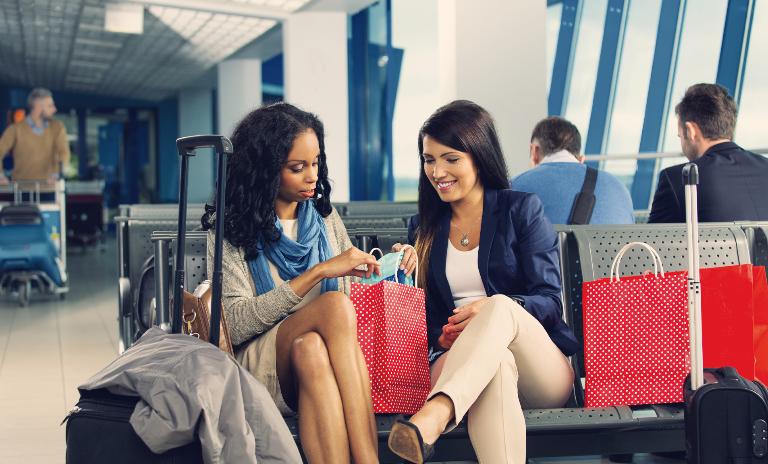
"Airports, retailers and the entire ecosystem must embrace the new market dynamics."

The Covid-19 pandemic has likely changed the air travel market for some time to come. Business travel has been decimated as workers switch to virtual mobility tools, one in five private travelers are choosing to fly domestically rather than internationally and passenger demand is set to remain well below pre-Covid forecasts for years to come, according to a recent Roland Berger study.
While airlines and airports have borne the brunt of the crisis, this reshuffled passenger mix has also had a profound impact on the travel retail sector. For example, fewer big-spending intercontinental passengers from Asia or Brazil mean fewer high-end sales, with retailers now having to adapt their offer to better suit the growing proportion of continental / domestic passengers, and especially low-cost passengers. On the other hand, less traffic and strong concerns over Covid-related delays at airports mean passengers are spending longer periods in airports, pushing up idle times available for shopping.
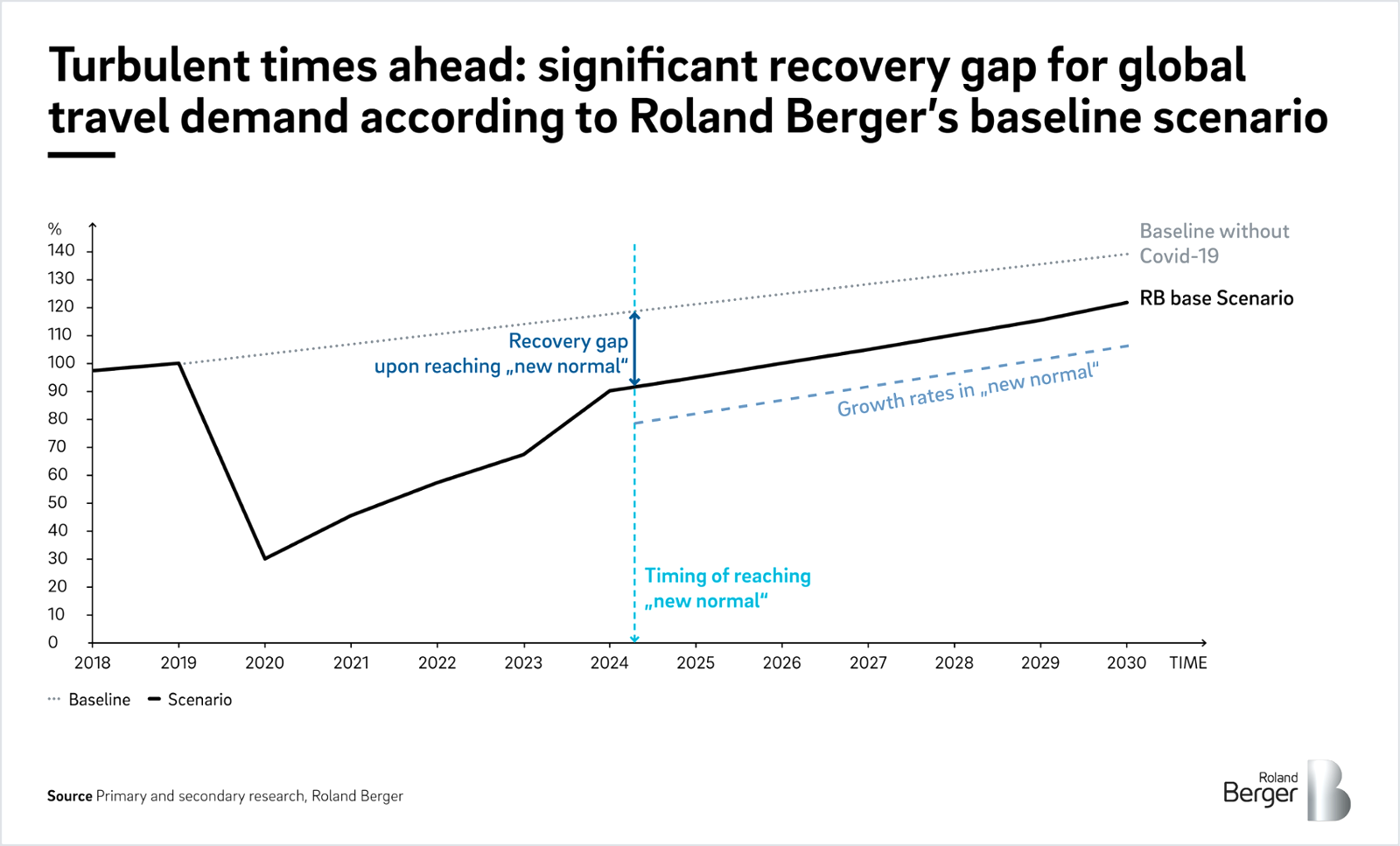
"Airports need to refocus their offer on their core passengers. They must adapt their product assortment and merchandizing to target the growing share of low-cost passengers."

New trends = new behaviors
This shift has accelerated several trends in travel retail, some that existed pre-Covid and some a result of the pandemic. First, the digital effect has become more pronounced. Retailers’ and brands’ omnichannel strategies are increasingly influencing clients, and e-commerce is driving up pricing transparency. Second, new forms of competition, such as social media use and music and video streaming are vying for passengers’ idle time. Third, the range of offers at some airports, which for years have been focused on either luxury or high-volume items, are becoming less attractive. Fourth, passengers now expect more than just traditional airport “shopping”, with demand growing for experience-based events, especially virtual ones. Finally, opportunities are growing to capture and exploit passenger data.
These trends and the reshuffled passenger mix are driving changes in buyer behavior. With less traffic in airports, passengers are buying more because the quieter environment makes it more appealing to spend time in airport shops. Increased idle times also mean they stay longer. In addition, better price transparency means that passengers can more easily compare duty free offers against online or Main Street prices, and dismiss offers that are not the bargain they purport to be.
Recommendations: How can travel retailers adapt?
The upshot is that travel retail players need to adapt to survive. In short, airports, retailers and the entire ecosystem must embrace the new market dynamics. To do this, we believe they need to focus on two key areas: revamping their traditional offer and reinventing their business models. Below we give our recommendations.
"Collaboration between airlines, airports and travel retailers is essential to realize the potential of new business models."

Revamp the offer
Refocus on core passengers: Travel retailers know that some passengers spend more than others. Their traditional offer has always included a premium element (designer stores, upmarket boutiques and restaurants, etc.) to cater to them. But this low volume/high value market has been badly hit by travel restrictions placed on some of its biggest spenders, such as Asian or Brazilian passengers. As a result, airports need to refocus their offer on their core passengers. They must adapt their product assortment and merchandizing to target the growing share of low-cost passengers, who while traveling low cost, do not necessarily have lower purchasing power at the airport.
Renew formats: To stay fresh, travel retailers need to frequently reinvent their formats. These might include pop-up stores, shop-in-shops, live performances and games. Integrating modularity into the design of commercial spaces helps with this.
Modernize concepts: A purely transactional approach to travel retail is no longer enough. Players must develop concepts such as retail-as-a-media, where capturing data points on passengers is more valuable than making a sale. This involves showcasing, for example, electronics, with customers able to try out new products provided they register first.
Offer experiences: Memorable events can improve brand awareness, customer relations and sales. With their captive audiences, airports provide a perfect platform for surprising, entertaining events, such as concerts, virtual reality experiences and selfie-worthy backdrops.
Leverage data and AI: Good use of data can help turbocharge a retailer. For example, ultra-personalization can help to cement client relationships and performance can be improved by closely monitoring datapoints and adapting to changes accordingly.
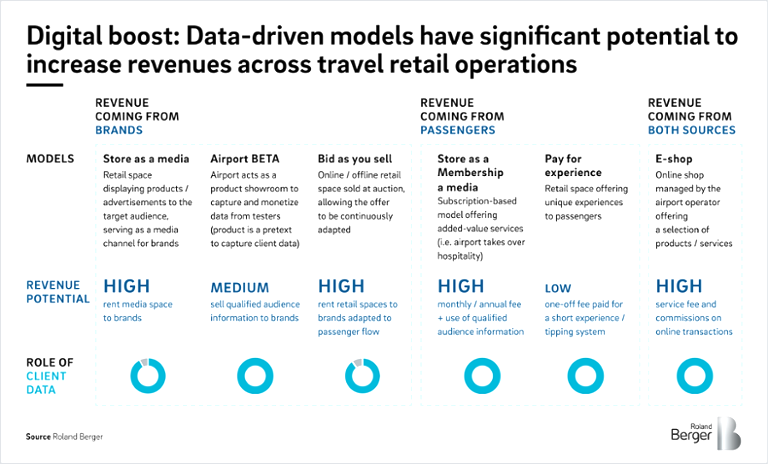
"Our expert teams have considerable knowledge of travel retail, and have supported airports, travel retailers, brands and airlines through a host of strategic and operational challenges."

Reinvent business models
Leverage cooperation and value sharing: Collaboration between airlines, airports and travel retailers is essential to realize the potential of new business models. This could include developing loyalty cards for a retailer or airline, or a branded payment card for a retailer.
Case studies: Roland Berger success stories
Our expert teams have considerable knowledge of travel retail, and have supported airports, travel retailers, brands and airlines through a host of strategic and operational challenges. The following case studies highlight two recent success stories. Feel free to get in touch for more information.
Case study 1: Airport
Project: A well-known European airport had a bottleneck in travel retail sales growth. Roland Berger was tasked with identifying the root cause and finding a transformation solution.
Approach: A comprehensive internal diagnosis identified declining sales per passenger as the root cause. Key factors behind this included passengers perceiving the retail offer to be expensive, an indifferent quality of assortment, insufficient consumer traction and a below-average commercial footprint.
Benchmarking against best practices at the airport’s leading competitors revealed it needed to step up to remain competitive. As such, we designed a commercial strategy with six key focus areas:

Case study 2: Duty-free retailer
Project: A leading Asian duty-free player wanted to win a concession in a major airport in Japan.
Approach: We conducted a thorough analysis of the retail RFP issued by the airport and compared it to the airport's specificities to determine the perfect requirements of its retail business. We identified three key needs, and proposed three corresponding KSFs:
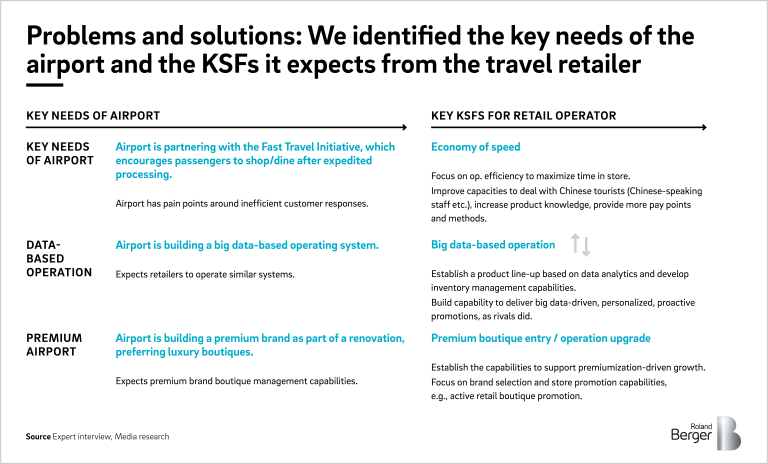
Partial recovery: How three trends are changing long-distance travel
We calculated the impact of three trends on four key travel dimensions to determine the "recovery gap" between pre-crisis long-distance travel and the post-pandemic situation.
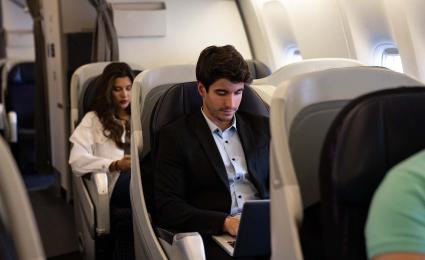
The future of long-distance mobility: How Covid jolted long-distance business travel
The outbreak of Covid-19 affected especially long-distance business traveling which is shown by a 66% globally decrease in air traffic last year.

The future of long-distance mobility: How Covid changed consumer appetites
The first part of our article series on long-haul mobility examines how private travel has forever changed, and why European demand might not return until 2025.

Transportation, Tourism & Logistics
Roland Berger supports the mobility and logistics industry in digitization along the entire value chain.

Smart Mobility
Smart Mobility contributes to a more sustainable and value-adding state of mobility. Find out more about new mobility scenarios for our society here.

- Publications
- Recommendations for successful travel retail

Related Expertise: Retail Industry , Transportation and Logistics , Sales Channel Strategy
Why Travel Retail Needs an Upgrade
September 04, 2018 By Filippo Bianchi , Gabriele Ferri , Stefano Minini , Ivan Bascle , Patricio Ramos , and Hean-Ho Loh
As the number of air travelers has surged in recent years, so has the amount of shopping that they do in airports. But while the so-called travel retail market has tripled in size since 2002, the rate at which passengers are spending has slowed over the past five years. To reverse this decline, airports, airlines, retailers, and brands will need to work together in innovative ways.
Some of those players are already launching ventures to boost performance, both in the airport and in the air. Among the most recent examples, Kuala Lumpur International Airport is building an integrated big data platform to support operations and provide real-time information to customers and airport operators; it will also facilitate passenger access to retail with features such as click and collect, where passengers buy products online that are subsequently delivered to their gate prior to boarding. In another venture, Singapore Airlines and duty-free operator DFASS have partnered with SATS, a gateway and food services provider, to convert onboard catalogs into an omnichannel e-commerce experience.
While such efforts are a step in the right direction, companies need to do more than launch standalone initiatives or even individual joint ventures. They must join forces to create a travel retail ecosystem through which they can share data about passengers’ schedules, purchasing behavior, and other related insights, and use that information to offer passengers a compelling shopping experience at every step of their journey.
More Passengers—and More Challenges
Over the past 15 years, the combined revenue of travel retail markets around the world has grown at a CAGR of 8.6%, at least twice as fast as any other offline retail channel. Today it stands at nearly $70 billion. (See Exhibit 1.)

Asia-Pacific travel retail in particular has exploded, with a CAGR of 14.4%. After surpassing Europe in 2011, the region currently accounts for almost half (45%) of global revenue.
Airline passenger growth has provided a major tailwind for the growth in revenue. During the same 15-year period, the number of global passengers increased by 5% year over year. (See Exhibit 2.) And travel retail is likely to expand even further: according to the International Air Transport Association (IATA), the number of passengers will double between 2016 and 2035.

Until recently, revenue growth was also driven by an overall improvement in product assortment and the customer experience. Spending per passenger rose throughout the first decade of the 2000s, peaking globally in 2013, but has declined ever since. (See Exhibit 3.)

Both the growth in the number of passengers and the slowdown in spending per passenger need to be viewed against the backdrop of a transforming aviation industry. The emergence of low-cost carriers (LCCs), shifting demographics, and the growing impact of new regions are changing the face of aviation—and presenting new challenges for travel retail.
Low-cost carriers are on the rise. With their competitive prices, LCCs are enabling new consumers to enter the aviation market; these carriers now claim up to 35% market share in key regions. By expanding into secondary airports, they have also opened up new markets for travel retail. Since the arrival of Ryanair in 2002, for example, the number of passengers at Milan’s Orio al Serio International Airport has grown from 1 million to 11 million a year, a growth rate six times faster than that of other airports in the region. And in keeping with their lean operating model, LCCs take a digital-first approach when it comes to things like booking and checking in for flights.
But while LCCs can help to stimulate further growth in travel retail, other carriers will need to tailor their offerings to the needs and priorities—and the spending patterns—of the new LCC customer base as well. This could involve, for instance, increasing food and beverage offerings rather than retail products or focusing more on mass-market chains instead of luxury retail. LCC-focused airports need to accommodate the airlines’ operational-efficiency requirements while maintaining the service quality expectations of their travel retailcustomers.
Market demographics are shifting. Aviation demographics are also undergoing substantial changes, with new age groups taking center stage. A BCG study on the evolution of travel habits found that, by 2020, millennials (those born between 1980 and 1994) will account for 46% of business trip spending in the US, an 11% rise from 2013. (See Traveling with Millennials , BCG Focus, March 2013.)
To stimulate the buying power of millennials, travel retail will need to leverage digitally driven, omnichannel, and loyalty-based platforms. Meanwhile, baby boomers (those born between 1946 and 1964) and members of Generation X (born between 1965 and 1979) will increasingly retire and spend more time traveling. Travel retail will need to provide those groups with convenient offers that appeal to their respective socioeconomic and demographic profiles in order to stimulate impulse purchases.
In addition to these generational changes, the number of affluent and free independent travelers (those who travel on their own, not in prearranged group tours) will also rise.
New regions are coming into play. More travelers are coming from the Middle East and Asia-Pacific, at a rate almost twice that of visitors from Europe and the Americas over the past ten years. When it comes to Chinese travelers, traffic is expected to increasingly come from outside the four tier 1 cities (Beijing, Shanghai, Guangzhou, and Shenzhen); consumers from tier 2 and 3 cities will drive consumption patterns that reflect the relative immaturity of those local retail markets.
In the meantime, the growth of global GDP has transformed large sections of major countries such as India from low- to middle-income status. And according to the IATA, once people have more disposable income, they tend to spend more on travel.
Travel Retail Remains Fragmented
Between February and April 2018, BCG in partnership with the Tax Free World Association (TFWA) conducted in-depth interviews with more than 20 senior managers at airports, airlines, retailers, and brands in three regions (North America, Europe, and Asia-Pacific). All managers agreed that, by operating in silos, key industry players limit the value they can deliver to customers. Rather than sharing information about passengers and coordinating to provide them with the most compelling offerings in the most appealing environment possible, travel retail players continue to go it alone in a fragmented market.
Integration is limited along the customer journey. Every point along the customer journey provides a buying opportunity. And airports and airlines have an unparalleled amount of real-time information about passengers as they make those journeys, from their age and nationality to their present and future locations. By not giving retailers and brands access to that data, they lose the ability to target customers with personalized offers.
Conversely, many retailers and brands don’t have the infrastructure to collect such data. Those that do gather information tend to focus on customer demographics, preferences, and buying patterns. But competition for concession contracts is fierce, and retailers and brands view their customer data as a source of competitive advantage. Rather than sharing the information, they keep it to themselves.
Players’ priorities conflict. On the basis of experience with an airport in Asia-Pacific, BCG has found that the amount of money passengers spend can increase by up to 2.5% for every extra minute they’re in the retail area. But security processes and airlines’ gate allocation, preboarding, and boarding requirements limit the amount of time passengers can spend browsing. (And free Wi-Fi means that many passengers stay away from the retail section altogether, choosing instead to sit in leisure areas and use their phones or laptops.) Another notable source of friction is related to the cabin allowance. A TFWA survey of nonshoppers indicated that 8% are uncertain about what they’re allowed to bring onboard (whether related to regulations or airline-imposed restrictions), which is one reason they don’t make a purchase in the retail area.
Quality is compromised, and assortments are limited. Contracts between airports and retailers tend to be short in duration, have razor-thin margins, and place the lion’s share of risk—such as fluctuating airport traffic levels and the inconsistent revenue stream that can result—onto the retailer. The result is that retailers must compromise on product quality and customer service. But TFWA found that the lack of value and selection were among the main reasons travelers didn’t make purchases.
Low margins and tight contract durations also force retailers to minimize their investments in new products and formats. Brands are subsequently unable to deliver their full array of assortments and pricing options to customers.
Standalone Improvements Generate Only Incremental Value
Airports, airlines, retailers, and brands are making notable changes to accommodate the shifts in passenger demographics and priorities. But individual improvements will take them only so far. They need to consider—and support—passengers’ entire travel experience.
Airports need to win market share by focusing on quality. Airports are increasingly looking for ways to generate revenue from nonaviation sources such as travel retail. Indeed, travel retail is a vital element when it comes to delivering a competitive experience, particularly for airports competing on premium routes. Improving terminal offerings helps attract new carriers and, with them, more passengers. But BCG research shows that more than 20% of passengers are still unhappy with the airport commercial area. Passenger complaints vary across airports, with the most common being poor Wi-Fi connections, dissatisfaction with the food and beverages available, and difficulty finding their way around.
Airlines need to offer more, and better, selection. In the face of strong pressure on profits from LCCs and other competitors, all carriers have been developing lean operating models—often to the detriment of travel retail, both onboard and in the airport. For example, in an effort to improve operational effectiveness, such as by reducing turnaround times and imposing one-bag carry-on limits and other constraints, airlines have also cut back on both the quality and the variety of products available to buy while in the air, causing growth in onboard retail to stagnate. Instead, they should be looking to partner with retailers to offer items that can be purchased during the flight and picked up upon landing.
Retailers need to focus on customer convenience and new formats . While leading travel retailers have consolidated to strengthen their financial performance, they could do more for the customer, such as making the shopping experience more convenient by offering click-and-collect systems or by enhancing loyalty schemes through vertical integration with airports and brands. Retailers could also improve their in-terminal formats, investing in innovative layouts and further distinguishing their product offerings from those of traditional retail channels.
Brands need to differentiate their offerings and formats. Brands are also refining their approach to travel retail—for example, by considering it as a separate channel and dedicating departments to it. Pricing strategies and customer service could be further improved, however, as could format innovation, even in a constrained environment such as the airport. One example is the new Louis Vuitton store in Singapore’s Changi Airport; opened in late 2017, it is the first LV airport store in Southeast Asia and features, among other things, a glass and copper-diamond mesh surface and a digital LED display at the entrance.
Building a Travel Retail Ecosystem
Travel retail’s ability to provide the customer with a compelling shopping experience while meeting the strategic challenges of new markets, changing demographics, and competition from online retail will hinge on how quickly and effectively airports, airlines, retailers, and brands can work together. By moving past their current silo mentality, they can create a travel retail ecosystem that makes personalization and integration core features of the passenger experience.
Industry players can take a number of steps toward creating such an ecosystem. These actions are grounded in two guiding principles: a renewed focus on the customer and the establishment of a value-based platform for cooperation and collaboration.
Use data to provide the customer an integrated experience. Convenience—in both price and delivery—as well as immediacy are two of the primary reasons online retail is so successful, and together, they give it a competitive advantage over today’s travel retail offerings. One way the travel retail industry can fight market erosion from online competition is to match the convenience and immediacy that online provides. Travel retail should enable purchasing at every stage of the customer journey, from booking and other pretravel activities, to time spent in the airport, to in-air travel—all the way through to after deplaning. A strong partnership among industry players, which a third-party technology provider could help to anchor, is critical. But the success of any technology platform will depend on its ability to integrate data from all players regarding products and services that can be offered along the traveler’s journey. (See the sidebar.)
Integrated Data Platforms in Travel Retail
Several travel retail players have already developed integrated data platforms. For example:
- AOE has developed an omni-channel and multimerchant marketplace for Frankfurt Airport, which hosts one of the largest shopping areas in Germany. Users can download the Frankfurt Airport app to browse products offered by selected retailers and receive related promotions, reserve products for purchase that they can collect at the gate once they’ve landed, and check their flight status in real time.
- Skybuys is a prototype app that integrates the offerings of more than 100 duty-free points of sale globally (in-airport, onboard, and downtown) for the frequent traveler. Users can browse offerings across multiple duty-free retailers, compare items by location, save items to wish lists, and reserve and collect purchases in the airport.
- Flio integrates more than 300 individual airport apps into one. For each airport, it provides a vast array of operational information, from airport maps to flight time- tables to lists of shops and services; a one-click connection to airport Wi-Fi; the ability to make in-app purchases for further travel; as well as lounge access and selected promotions from featured retailers.
Airlines (and their data) are a critical component of the ecosystem. They can play a role in increasing the value of the travel retail market in three ways, starting with passenger data. Unlike airports, retailers, or brands, airlines are the main point of contact with passengers. As such, they have an unparalleled amount of knowledge about their customers, which they’ve used to develop competitive pricing policies and precision-marketing strategies. And they could take this even further—for example, by offering customer information such as ticket fare class to retailers for use when marketing travel retail products. This data could be shared in exchange for transparent transaction fees.
Another way of increasing travel retail revenue is for airlines and retailers to form joint ventures to create digital platforms that complement onboard service. For example, Singapore Airlines and travel retail operator DFASS signed a joint venture agreement with gateway and food services provider SATS to move the catalogs they provide to passengers in the air onto an omnichannel e-commerce platform. With such agreements, retailers can expand their ability to reach customers, and airlines can shore up any limitations in their product offerings while still maintaining operational efficiency.
In addition, airlines could allow a wider variety of goods to be promoted during check-in and at the booking stage. And they could provide complementary onboard travel retail services. For example, the online brand REWE is trialing an onboard grocery-shopping offering with Lufthansa that allows passengers on selected long-haul flights to shop for products that can be delivered once they arrive home.
Enhance the customer experience, from terminal planning to in-store execution. The travel retail industry should focus on building differentiated offerings that deliver a surprise effect. For example, in early 2018, Tiffany used its iconic blue packaging to draw passengers to its pop-up store in John F. Kennedy International Airport’s Terminal 4.
Excellence in customer experience starts with retailers and airports sharing a common understanding of the core principles that govern terminal design and passenger acquisition strategies. For example, when planning a terminal expansion, operators of one European airport engaged heavily with their commercial partners to establish criteria for space allocation and passenger flows. Engagement with large retailers started four years before the terminal opened; with select luxury brands, engagement began two years before it opened.
When it comes to operations, travel retail needs to be flexible enough to respond to changes in the number of passengers in different locations and at various times of the day in order to maintain profitability. One example is the integrated big data platform that Kuala Lumpur International Airport is deploying for its KLIA2 terminal. The platform will pull in data about passengers’ real-time locations throughout the airport so that services and supports can be adjusted to seamlessly accommodate fluctuations in passenger flow. Airports can also use big data and analytics to better manage resourcing, parking congestion, and in-terminal retail assortments.
The first steps toward this transformation have already been taken. Brands and retailers are developing new formats by using technologies such as video and augmented reality. They’re also embarking on enhanced partnership agreements with airports to create new formats, such as pop-up shops, that can occupy unused terminal space while providing novelty to travelers.
Refocus on the customer with tailored products, pricing, and promotions. Retailers and brands must further integrate around products to deliver differentiated offerings, starting with a shared understanding of customer demographics and purchase patterns.
According to Swiss travel retail research firm m1nd-set, the top two reasons Chinese consumers say they buy duty-free items are that they offer good value for money and a clear price advantage. With that in mind, the travel retail industry should exploit the price advantage offered by tax exemptions on core categories. That will allow them to compete with prices found elsewhere, whether online, downtown, or at the passenger’s destination, especially given that those other prices can be discovered with a simple web search. One solution—already widespread among e-commerce retailers—could entail the introduction of dynamic-pricing policies to match those of the competition.
The industry can also take advantage of airports’ intrinsic data richness, pooling customer information with real-time data to further tailor promotions and marketing campaigns. An example is the data-driven advertisement initiative jointly developed by Dubai International Airport, Dubai Duty Free, and JCDecaux. Together, they created a marketing ecosystem that integrates all their data to optimize ad scheduling, boosting the efficiency of campaigns. Retailers can change their artwork every 15 seconds using different languages and promotions according to the time of day and the expected passenger flows in the airport.
Three Ways to Start Working Together
To help airports, airlines, retailers, and brands craft their next steps, we offer three business model archetypes for partnerships that could provide the foundation of a travel retail ecosystem.
A Data-Driven Marketing and E-Commerce Platform
The industry could partner with a third-party technology provider to create an integrated, data-driven global-insights platform that could increase the number of marketing opportunities by focusing on customer outreach before travel starts and on convenience both during and after the journey.
All industry players would share data about their customers—from their age and nationality to their brand loyalty status—in a way that complies with privacy regulations. The platform would systematize and orchestrate the exchange of that data in return for a fee. For increased impact, the ecosystem could be extended to include, for example, hotels, parking operators, and online travel agencies.
The platform would then feed into a second, commercial platform that enables comarketing activities among airlines, airports, brands, and retailers. Given their natural connection with the customer, airlines and brands would serve as the touchpoint channels, while retailers and airports would provide the right assortment, resources, and areas for the comarketing activities.
The platform could be used to push targeted airport retailer promotions when the customer is engaged with the airline, either at check-in online (such as discounts on family meals or parking promotions) or while onboard (for example, a click-and-collect system at the gate during a stopover). Brands could also leverage the platform to increase the span of services they offer customers, such as the ability to collect or return items purchased online during a forthcoming airport visit.
Similar platforms are already being developed in adjacent markets. One example is Journera, a back-end data platform that collects passenger information from participating travel partners to provide a single, real-time snapshot of passengers that participants can use to offer a customized experience. For example, a hotel operator could see that one of its guests landed ahead of schedule and offer an early check-in time.
A Passenger Control Tower
Today, passenger flows are static and operations-driven. Airports allocate gates on the basis of customs officer availability, aircraft turnaround times, and ground handling requirements, for example. To give passengers a better experience while maximizing the amount of money they spend, airports could work with airlines, retailers, and brands to develop a digital passenger control tower. (See Exhibit 4.)

This tool would take data from multiple sources (retailers, airlines, airports, and data streams produced through passengers’ digital devices via airport Wi-Fi) and pertaining to multiple fields—from passenger purchasing preferences to flight departure times. Using this data, the system would then provide real-time passenger information to retailers, such as point of origin or destination, and would optimize a series of airport-critical operations that would help to direct passenger flow. For example, the system would dynamically redesign gate allocation in order to maximize passenger exposure to the retail areas most appealing to them.
Airports would need to lead the development of this tool, setting criteria and providing the operating resources. Robust data platforms and innovative partnership agreements would be especially important because success would depend on airlines sharing their passenger information, brands and retailers defining their potential interest, and airports dynamically allocating suitable gates while ensuring that minimum levels of operational service are fulfilled.
Small-scale mockups undertaken for specific airports have already shown that such tools can deliver significant increases in spending per passenger.
A Personalized Pricing and Assortment Tool
Today’s customer wants personalization and special treatment on the basis of loyalty. Moreover, travel retail customers are rational in their purchase decisions and often compare prices online even while in airports. Retailers can take the lead in improving customer personalization by devising a real-time, personalized pricing and assortment tool.
The system would leverage the intraday difference in passenger mix as well as the inherently data-rich environment of the airport to optimize and dynamically offer pricing, promotions, and assortments. The ultimate objective of this type of system would be to reorient the product mix, increase spending per ticket, and generate more impulse purchases. Such a tool would be especially helpful during an economic downturn, when spending per passenger needs to compensate for any shortfall in the number of travelers.
For input, the system would require airport information, such as flight schedules and the position of passengers in the retail area using beacons and Wi-Fi, consumer brand preferences, and third-party information such as downtown benchmark prices or the weather in a destination city. For example, the system could optimize duty-free prices and special offers at an airport in Antalya, Turkey, prior to the departure of an evening flight to Russia in order to align with prices in downtown Moscow and the categories preferred by Russian consumers.
Online retailers already make plenty of daily adjustments to prices as well as to promotions, and similar experiments are also taking place in many brick-and-mortar retail stores. To achieve comparable results in the airport environment, retailers would need to coordinate their efforts and—most important—they would have to invest in adapting their systems to dynamic pricing, all of which would require that they revise the compensation terms of their concession contracts.
The travel retail industry has experienced exceptional growth over the past 15 years. But while an increase in the number of passengers has been a major tailwind, airports, airlines, retailers, and brands have contributed to the development of the sector as well. In the past five years, however, signs suggest that the market is reaching a turning point, with travel retail spending per passenger dropping in all regions around the globe.
To reverse that decline, airports, airlines, retailers, and brands need to abandon their current silo approach and instead create a travel retail ecosystem. Only by sharing information, aligning operational priorities, and integrating along the entire customer journey can the travel retail industry reverse the current falloff in passenger spending and stave off any further declines.

Managing Director & Senior Partner, EMESA Regional Lead, Fashion & Luxury Industry

Managing Director & Partner

Project Leader

Managing Director & Senior Partner

ABOUT BOSTON CONSULTING GROUP
Boston Consulting Group partners with leaders in business and society to tackle their most important challenges and capture their greatest opportunities. BCG was the pioneer in business strategy when it was founded in 1963. Today, we work closely with clients to embrace a transformational approach aimed at benefiting all stakeholders—empowering organizations to grow, build sustainable competitive advantage, and drive positive societal impact.
Our diverse, global teams bring deep industry and functional expertise and a range of perspectives that question the status quo and spark change. BCG delivers solutions through leading-edge management consulting, technology and design, and corporate and digital ventures. We work in a uniquely collaborative model across the firm and throughout all levels of the client organization, fueled by the goal of helping our clients thrive and enabling them to make the world a better place.
© Boston Consulting Group 2024. All rights reserved.
For information or permission to reprint, please contact BCG at [email protected] . To find the latest BCG content and register to receive e-alerts on this topic or others, please visit bcg.com . Follow Boston Consulting Group on Facebook and X (formerly Twitter) .
A travel boom is looming. But is the industry ready?
If things go well, we might be at the threshold of a new age of travel. Although COVID-19 variants may affect conditions, it seems only a matter of time before travelers in some parts of the world hit the road and take to the skies again, thanks to rising vaccination rates and manageable caseloads. Some countries have begun gingerly relaxing travel restrictions and reopening borders.
As the worst effects of the COVID-19 pandemic ebb, most indicators point to travel coming back—with a vengeance—as people look to reconnect, explore new destinations, or revisit reliable favorites. Many just want to get away from the confines of their homes. A McKinsey survey reveals traveling to be the second-most-desired activity among respondents (in first place: dining out). In the United States, air travel has hit two million daily passengers, closer to the prepandemic level of around 2.5 million than to the low of around 90,000, in April 2020. Hotel reservations and rental-car bookings are surging.
All these trends should taste sweet for the industry, but ill-prepared companies may find themselves facing the wrath of a cohort of leisure-focused vacationers who might already be struggling to keep up with new travel protocols. If the industry doesn’t work to increase capacity now, the ecosystem may buckle under the pressure, forcing travelers to endure long wait times and inflated prices.
This article projects two broad trajectories of how travel will likely bounce back, comparing countries that have near-zero caseloads with those that have more, but manageable, caseloads and higher vaccination rates. In both scenarios, travel companies that don’t prepare themselves for the forthcoming influx of travelers risk missing out on a valuable opportunity to recoup losses incurred during the height of the pandemic. On the flip side, we believe that by focusing on four key areas—building capacity, investing in digital innovation, revisiting commercial approaches, and learning from critical moments—travel companies can seize value as they exceed the needs and demands of their customers.
The tale of two travel recovery paths
Wherever in the world you look, you’ll see people itching to travel. Most high-income earners have not lost their jobs. In the United States, the savings rate among this demographic is 10 to 20 percent higher now than before the pandemic, and such people are eager to spend their money on travel. Leisure trips are expected to lead the rebound, with corporate travel trailing behind.
A recent survey of 4,700 respondents from 11 countries around the world, conducted by the International Air Transport Association (IATA), revealed that 57 percent of them expected to be traveling within two months of the pandemic’s containment, and 72 percent will do so as soon as they can meet friends and family. In our China travel survey, we see more and more respondents yearning for leisure trips further afield; 41 percent say they want their next trip to be outside China, the highest level we’ve seen, despite borders remaining sealed.
Yet it’s worth noting that despite the near-universal desire to travel, countries will likely manage their plans to reopen differently. Two main factors come into play here: current COVID-19 caseloads and vaccination rates. People living in countries with limited access to vaccines and uncontainable levels of cases—such as a number of countries in Africa and Southeast Asia—will continue to be bound by tight travel restrictions for some time to come.
Travel will take off in and between countries with manageable caseloads
We can expect a surge in travel in (and between) countries with manageable and moderate COVID-19 caseloads and vaccine access. These regions are willing to accept rising case levels as long as death and hospitalization rates stay low. In many European countries and the United States, a significant portion of the population has been inoculated. Such people feel safe enough to travel both domestically and internationally, especially with the introduction of safety measures such as the EU-issued digital health certificates given to people vaccinated against COVID-19. Despite fluctuating rates of new caseloads in these regions, the efficacy of the vaccine so far (to reduce the spread of the disease and avoid its worst effects) gives many people enough feeling of security to travel.
Countries in Europe that have gotten used to living with manageable caseloads of COVID-19 have begun to welcome visitors without asking them to quarantine: Iceland (March 2021), Cyprus (May 2021), and Malta (June 2021). In addition, Europe is open to vaccinated US travelers. After the US Centers for Disease Control and Prevention (CDC) started approving cruise vessels with conditional sailing certifications to enter the country, a Florida federal court ruled in June 2021 that CDC-issued regulations should serve only as nonbinding guidelines, further reducing restrictions on tourists.
If past instances serve as indicators, we’ll see travel demand soaring once travel restrictions are eased and freedom of mobility returns.
Domestic trips will lead the recovery of travel in near-zero countries
However, a slightly different picture is emerging for countries with near-zero caseloads. Countries in this group include Australia, China, New Zealand, and Singapore. Their governments face a difficult trade-off. They can open up national borders without quarantines—which will almost certainly lead to increased local transmissions of COVID-19 and an increase in new cases, especially in countries with low vaccination rates, such as Australia and New Zealand. Or, they can choose to continue imposing strict restrictions and quarantine measures until the pandemic has truly passed, which would deter all but the most determined of travelers. Unlike places that have adjusted to living with COVID-19, even a moderate increase of cases in countries with caseloads near zero would likely be unacceptable to the public.
That’s not to say there are no travel opportunities in these countries. First, we’ll likely see increased interest in domestic travel, especially for large countries with sizable home markets, such as Australia and China, which have traditionally been net exporters of tourists. With few international destinations open to visit, this group of travelers will likely seek out vacation experiences within their nations’ borders. China has seen hordes of tourists flood many scenic destinations and tourist sites, especially during peak travel seasons.
Second, even though travel bubbles have had only limited success so far, it may soon be possible for territories with very low COVID-19 caseloads and no local transmissions to open up access to each other. Mainland China, for instance, has been allowing citizens to travel to and from Macau without quarantine requirements. Hong Kong and Singapore have also restarted negotiations on a potential travel bubble between the two cities. The key is establishing common standards and trust in the public-health protocols and testing regimes of the participants in the travel bubble.
Four actions travel players must consider
Despite these promising signs, the tourism industry will likely struggle to capitalize on the imminent spike in travel demand, especially in Europe and the United States. From airlines and car rentals to hotels and airport restaurants, the entire travel supply chain is already showing signs of strain. Wait times at security checkpoints are stretching into hours at some airports, while popular vacation destinations, including Arizona, Florida, and Hawaii, are facing rental-car shortages.
Needless to say, bad news travels fast, and a negative experience can quickly become fodder for a viral video and bad publicity, leading customers to look for alternatives more in their control, including nearby drives and rental properties.
While the process is daunting, clear-sighted travel leaders know that preparing their organizations for a surge of travelers is also an opportunity to redefine their value propositions and make their offerings distinctive. This will not only reinstill confidence in travel but also increase customer loyalty. Leaders and executives would be wise to focus on the following four areas.
1. Bring back capacity
The most pressing imperative for all companies across the travel supply chain is bringing back capacity or, at the very least, ensuring that they’re able to do so. Many contract and temporary workers in the restaurant industry who were laid off during the pandemic have found other employment and are reluctant to go back to their former jobs, resulting in a labor crunch. In the United Kingdom, more than one in ten workers left the hospitality sector last year. In the United States, there was still a shortfall in April of around two million leisure and hospitality jobs—far greater than before the pandemic. Global aviation capacity levels are still well below prepandemic levels as many planes remain in long-term storage and staff remain furloughed. We believe that even though reactivating airline pilots and cabin crews, preparing grounded aircraft for service, and rehiring and training service staff can be pricey, the cost of standing by and doing nothing would be higher.
2. Invest innovatively to improve the entire customer journey
While cash might continue to be in short supply, an area still worth considering for overinvestment is digital operations. Remember that the customer experience is shaped across the entire end-to-end journey, from booking to travel to the return home. Even seasoned travelers will have to adapt to new protocols, such as digital health certificates and safety measures. Travelers now need more, not less, assistance. Furthermore, certain critical journeys and moments—such as a family vacation, an important business trip, or a last-minute emergency—carry a disproportionate weight in consumers’ minds when they plan their next trip. The anticipated volume of traffic during the summer and peak holiday periods will only compound these issues and bring about greater inconvenience in the overall system.
In our work in this sector, we have found that if even one pain point in the customer journey is not satisfactorily resolved, the entire perception of a travel company can be degraded. The industry needs to make sure that processes are smooth for reopening and that adequate assistance is available for travelers to help them adapt to new ways of traveling. It is likely that international trips will need additional documentation for some time. These requirements will vary by country and potentially by transit hub. They may include proof of COVID-19 vaccination (when, as well as which vaccine) and testing requirements (type of test and recency).
As the long wait times at airport checkpoints attest, manually navigating these complexities at the check-in desk is highly inefficient and prone to human error. Some airports are testing camera-powered and AI-based digital technologies to monitor crowd densities and reduce time spent standing in line—which makes the airport experience more bearable for travelers and ensures safe physical distancing. Autonomous robots are also being deployed to maintain hygiene standards; some are equipped with UV-light cleaners to disinfect areas, and others are outfitted with body-temperature sensors to help minimize the risk of virus outbreaks.
3. Reimagine commercial approaches
Travel companies may rethink their commercial approaches. The profiles of airline passengers and hotel guests will be different: more leisure guests, later booking windows, and higher demand for flexible tickets. Historical booking curves are no longer a good indicator of current behavior. Travel companies need to use every source of insight they can to anticipate demand and optimize pricing . Flexible pricing models can also ease customer discomfort with today’s heightened levels of unpredictability. For example, EasyJet now offers a Protection Promise program that gives fliers free changes up to two hours before the flight.
Hotels will need to find new purposes for meeting and conference spaces, which will be slower to fill. Airlines need to figure out how to fill intercontinental business class, likely with premium leisure promotions. For all travel companies, the boom may be higher in traveler numbers than in profits, as the most lucrative corporate business has been slow to return.
4. Learn from critical moments—and the wider ecosystem
Aside from streamlining processes and personalizing the customer experience, investing in digital analytics can allow companies to identify opportunities to differentiate their services. Companies would also be able to discern emerging trends and hiccups before they turn into nightmares. Industry players, such as online travel agents, may also be a trove of useful insights pertaining to how the external ecosystem is evolving; their experiences may be beneficial for hotels and airlines to explore potential partnerships with them.
The various parts of the travel industry have to work together as a whole to usher in a safe return of travel. Even as individual companies improve their internal operations, they should also keep a close eye on industry-wide developments, watching for collaboration opportunities. The industry and governments will have to reach consensus on safety standards and requirements. The IATA travel pass is a plug-in that could be used on airlines’ mobile apps, for example. Currently being tested by many airlines as a way to ensure passenger health, the app would allow travelers to manage verified certifications for COVID-19 vaccines and test results. Governments, in turn, could consider accepting and embedding the app into the flight check-in workflow.
It’s been a long time coming, but we see several factors aligning that could lead to a short-term travel boom, although not all countries and customer segments will boom at the same time. With continued perseverance, travel companies can ensure that travel is not just back but better.
Vik Krishnan is a partner in McKinsey’s San Francisco office; Darren Rivas is the director of capabilities, Global TLI, in the Atlanta office; and Steve Saxon is a partner in the Shenzhen office.
This article was edited by Jason Li, a senior editor in the Shanghai office.
Explore a career with us
Related articles.

The comeback of corporate travel: How should companies be planning?

The path to recovery for US hospitality
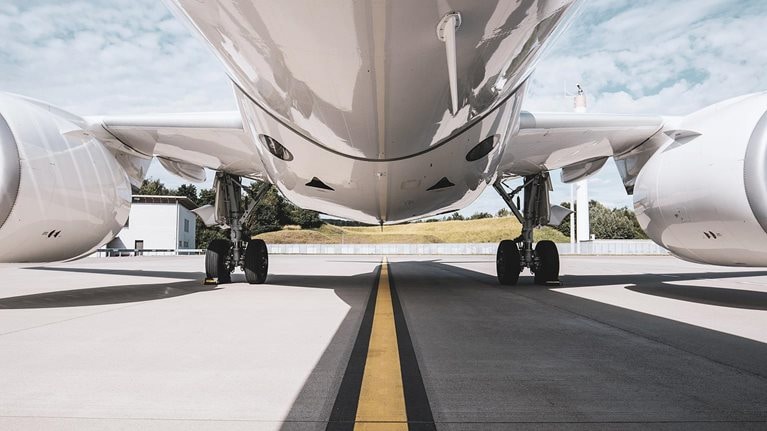
How air travel is evolving postpandemic
- Top Travel Retail Companies
"We Envision Growth Strategies Most Suited to Your Business"
Increasing Introduction of Duty-free Campaigns to Boost the Market for Top Travel Retail Companies
February 01, 2023 | Consumer Goods
The travel retail industry revolves around cruise ships, airport duty-free shops, and airlines. The industry is made up of four primary channels, each of which is completely unique. Each channel has a different passenger profile, consumer behavior, and business dynamics.
Fortune Business Insights stated that the global market size for travel retail was valued at USD 51.28 billion in 2021. The global market is projected to grow from USD 55.74 billion in 2022 to USD 96.11 billion by 2029, exhibiting a CAGR of 8.1% during the forecast period.
Below mentioned are the four types of travel retail platforms:
- Airport
Airports across the world have stores in the terminals for arrivals and departures, allowing passengers to shop while on the go. In terms of sales and the number of passengers, it is the largest channel in the travel retail sector and the key growth engine for the sector.
- Aircraft
Pre-ordered or in-flight purchases of goods are possible during flights, and both digital entertainment options and paper catalogs are accessible. It is a channel that commands the full attention of passengers yet necessitates carefully chosen strategic merchandise and meticulous attention to detail to ensure success.
- Cruise Ship
Cruise ship allows for possibilities for shopping at sea while moving between ports globally, allowing passengers to utilize the long transit time to repeatedly explore travel retail offerings. Cruise ships offer the market a rapid growth trajectory, particularly as young passengers have an inclination to become more popular.
- Downtown Duty-free
It offers opportunities for shopping that let visitors from other countries buy tax-free goods right away or reserve them to pick up after customs at the airport. It is a channel that focuses on the rapidly expanding trend of duty-free shopping outside of the typical channels, particularly in the Asia Pacific region.
Below mentioned are the top 10 travel retail companies around the world:
1. Lagardère Group
Lagardère Group is an international group headquartered in Paris, France, with operations in more than 40 countries worldwide. The group started functioning in 1852. The company houses Burberry, Gucci, Hermes, and Victoria's Secret products and adopts various strategies such as acquisitions and partnerships to grow its sales.
2. LVMH (DFS Group Ltd)
DFS is a luxury travel retailer established in 1960 and headquartered in Hong Kong. It offers a broad spectrum of product categories, including wines & spirits, perfume & cosmetics, and fashion accessories. These companies target international travelers in Europe, the Americas, Asia, and the Middle East.
The company has around 400 boutiques spread over 13 countries offering high-end products.
3. Dufry AG
Dufry is a Swiss-based travel retail company established in 1865. It operates more than 2,300 duty-paid, duty-free shops and convenience stores in cruise lines, seaports, railway stations, airports, and central tourist areas worldwide. The company is headquartered in Basel, Switzerland and employs approximately 36,000 individuals worldwide.
4. King Power International Group
King Power International Group is a Thai company based in Bangkok and established in 1989. The group has three primary duty-free operations in Thailand. It operates through four business units, travel-retail, hotel, travel and sports-related.
The group provides duty-free beauty & cosmetics, fashion, and electronic products for travelers in its retail stores. It mainly focuses on competitive strategies such as collaborations and joint ventures with various luxury brands to generate higher revenue.
5. DAA (Aer Rianta International)
Aer Rianta International, headquartered in Dublin and established in 1988, is one of the significant players in the global market. The company manages and owns duty-free retail outlets in Europe, the Middle East, Asia Pacific, and the Americas.
6. Delhi Duty-Free Services Pvt. Ltd.
Delhi Duty-Free Services Pvt. Ltd is a joint venture between Delhi International Airport Limited, Yalorvin Limited, and GMR Airports Ltd. The company's flagship store is at Delhi International Airport. It also has 11 stores that offer products such as watches & jewelry, toiletries & cosmetics, apparel, liquor, and tobacco products. The group focuses on introducing novel products at its flagship stores.
7. Lotte Duty-Free
Lotte Duty-Free is one of Korea's leading duty-free operators, established in 1980. The brand has its presence in 19 locations across 7 countries. Lotte Duty-Free also has an online presence that is accessible from any place. The company provides 1,613 brands as of 2019 and is expanding globally to reach more travelers worldwide.
8. Gebr Heinemann SE & Co. KG
Gebr Heinemann SE & Co. KG is a German travel retailer established in 1879. The company operates duty-free shops, fashion-label boutiques at international airports along with stores on board cruise ships and border crossings. The group provides perfumes & cosmetics, confectionery, wine & spirits, fashion & accessories, watches & jewelry, and tobacco products.
9. China Duty-Free Group Co. Ltd.
Established in 1984, China Duty-Free Group is a state-owned organization that operates duty-free businesses across China. It works in 90 cities across 30 provinces of China and has over 200 retail stores. The company strongly focuses on launching new stores and introducing innovative products.
In December 2021, the company launched its first flagship store, CDF Macau Grand Lisboa Palace Shop, in Macau, China. The store offers over 170 brands of fashion, watches, accessories, cosmetic products, jewelry, perfumes, culinary delights, wines, and souvenirs.
10. Abu Dhabi Duty-Free
Established in 1984, Abu Dhabi Duty-Free operates and manages retail, food & beverage, and service operations in the airport's facilities. The group offers an array of duty-free products, high-street stores, luxury boutiques, and theme-based dining outlets. Abu Dhabi Duty-Free's product categories include beauty, fragrances, watches, toys, food, and souvenirs. The company aims to open new stores in airports and cruises to promote its brands.
Duty-free Campaigns are Regularly Offered by Retailers to Increase Product Demand
Nowadays, leading businesses use marketing campaigns to entice customers to purchase duty-free goods. For the higher-income airport traveler groups, businesses also consistently offer high-quality, privately labeled goods and services. The product sales at the airport's retail stores are expected to be aided by the above-mentioned factors.

To Gain Further Insights on this Market, Write Us:
Thank you....
Our Clients
Inquiry Before Buying
+1 424 253 0390 (US)
+44 2071 939123 (UK)
+91 744 740 1245
[email protected]

Jewelry Market

Luxury Goods Market
Skincare Market
Pet Care Market
I hope you enjoy reading this blog post.
To receive tailor made services, feel free to share your research requirements.
Enter the valid email address

UPDATE: MEA fuels Heinemann turnover to €3.6bn
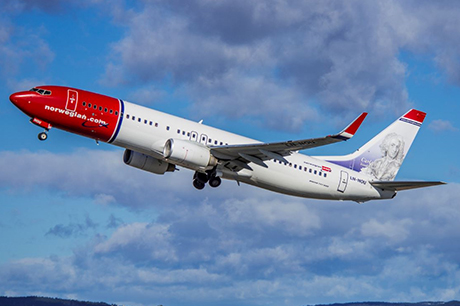
Norwegian and gateretail offer pre-order duty free on selective flights
Passengers on board select Norwegian Air Shuttle (Norwegian) flights departing from Oslo can now pre-order duty free items directly to...

Bulgaria’s Sofia International Airport home to new Avolta walkthrough
Global travel retailer Avolta and Sofia International Airport operator SOF Connect have opened a new walkthrough retail store at...

Arnaud Lagardère steps down from exec roles due to indictment
Lagardère SA, owner of Lagardère Travel Retail, has revealed that its Chairman & CEO Arnaud Lagardère has provisionally stepped...

ATÜ Duty Free opens first Canada Goose store in Turkey at IST
ATÜ Duty Free – the TAV Airports and Unifree Duty Free/Gebr. Heinemann subsidiary – has debuted Canada Goose in Turkey at Istanbul...

ASUTIL Conference 2024: Agenda, speakers & networking announced
The Asociación Sudamericana de Tiendas Libres (ASUTIL) has revealed a compelling lineup of speakers for its upcoming conference in...

CEETRA Travel Retail Forum: Appeal of homegrown brands a top talking point
The Central and Eastern European Travel Retail Association (CEETRA) welcomed a broad cross-section of industry stakeholders from across...

WHSmith interim results show strong TR growth as it eyes more locations
WHSmith has posted strong growth figures for the first half of FY24, with its total travel retail revenue rising 13% yoy to £670m, as...

Düsseldorf Airport seeks experienced partners for F&B/retail tenders
Düsseldorf Airport has launched multiple tenders - running in parallel - for the development of twelve F&B areas, alongside those...

John Rimmer to join TR Consumer Forum moderation team in Dubai
TRBusiness is pleased to announce that former TFWA Managing Director and seasoned conference moderator John Rimmer has teamed up with...

TRBusiness Summit Shorts: Otis McAllister on confectionery’s evolution
Americas travel retail distribution firm Otis McAllister has reaffirmed its commitment to the confectionery category underpinned by...
Global travel retailer Avolta and Sofia International Airport operator SOF Connect have opened a new walkthrough retail store at Terminal...
Lagardère SA, owner of Lagardère Travel Retail, has revealed that its Chairman & CEO Arnaud Lagardère has provisionally stepped down from...
ATÜ Duty Free – the TAV Airports and Unifree Duty Free/Gebr. Heinemann subsidiary – has debuted Canada Goose in Turkey at Istanbul Airport...
Latest Product News

Into the wilderness: Wildmoor gets liquid to lips with intimate GTR preview
TRBusiness was on location at 1 Hotel Mayfair in central London today (29 April) for a special preview and tasting of two new global travel retail...
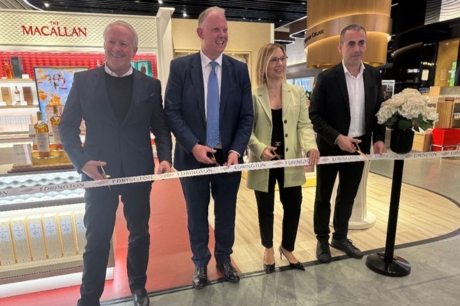
Edrington celebrates Macallan and Highland Park shop-in-shop firsts
Edrington Global Travel Retail has partnered with Unifree and Gebr. Heinemann to open a “world-first” shop-in-shop at Istanbul Airport showcasing both...
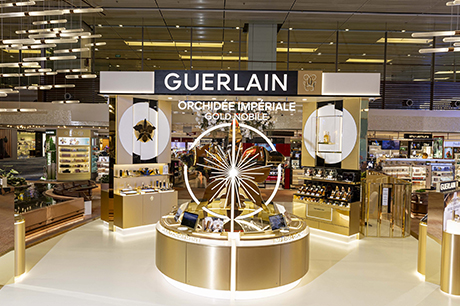
Guerlain brings Orchidée Impériale Gold Nobile pop-up store to Changi
PROMOTED CONTENT: French haute perfumery, skincare and makeup house Guerlain is celebrating the launch of its new-generation age-defying skincare Orchidée...
The Asociación Sudamericana de Tiendas Libres (ASUTIL) has revealed a compelling lineup of speakers for its upcoming conference in Bogotá,...
The Central and Eastern European Travel Retail Association (CEETRA) welcomed a broad cross-section of industry stakeholders from across the...
WHSmith has posted strong growth figures for the first half of FY24, with its total travel retail revenue rising 13% yoy to £670m, as it...
Düsseldorf Airport has launched multiple tenders - running in parallel - for the development of twelve F&B areas, alongside those for books...
TRBusiness is pleased to announce that former TFWA Managing Director and seasoned conference moderator John Rimmer has teamed up with TRBusiness...
- Product News
TRBusiness was on location at 1 Hotel Mayfair in central London today (29 April) for a special preview and tasting of two new global travel...
Edrington Global Travel Retail has partnered with Unifree and Gebr. Heinemann to open a “world-first” shop-in-shop at Istanbul Airport...
PROMOTED CONTENT: French haute perfumery, skincare and makeup house Guerlain is celebrating the launch of its new-generation age-defying skincare...

R.O.C.K.S. Whiskey Chilling Stones speeds expansion with Lufthansa listing
SPONSORED CONTENT: R.O.C.K.S. Whiskey Chilling Stones is gaining traction inflight, with a new listing with Lufthansa going live on 1 April,...

Monarq Group teams up with DFS to introduce Condesa Gin to JFK T4
Monarq has partnered with DFS to introduce Condesa Gin at John F. Kennedy (JFK) International Airport Terminal 4. This artisanal,...

Pernod Ricard GTR, ARI & Redbreast launch Cuatro Barriles Edition at DUB
Pernod Ricard Global Travel Retail (GTR), ARI and Irish Distillers have teamed up to celebrate the launch of the travel retail exclusive (TREX)...

Rocks Whiskey Chilling Stones enters Europe TR with Lufthansa listing
Rocks Whiskey Chilling Stones has made its European travel retail debut with an inflight retail listing with Lufthansa for its best-selling...


Pernod Ricard joins forces with Avolta on new Chivas Regal promotion
Pernod Ricard Global Travel Retail (PRGTR) and Avolta have launched a new consumer promotion linking Chivas Regal and Manchester United Football...

Pöschl Tabak’s Pueblo brand lands in duty free in more than 120 airports
Germany-based Pöschl Tabak has launched its Pueblo fine cut tobacco brand into global duty free. Described as being 'manufactured without...

Ian Macleod Distillers premieres portfolio at Summit of the Americas
Ian Macleod Distillers (IMD) is showcasing its portfolio of premium and super-premium spirits at IAADFS Summit of the Americas for the first time,...

Confectionery & food most cross-selling category in Americas, says Nestlé
Nestlé International Travel Retail (NITR) is eyeing substantial growth in the Americas region as the company makes its appearance at the IAADFS...

Mars Wrigley ITR pushing moment-led strategy at IAADFS Summit of Americas
Mars Wrigley International Travel Retail (MWITR) arrives at this year's Summit of the Americas to focus on a moment-led strategy to excite and...
Most popular
- Regional News
- Channel News
- Data & Analysis
- Video Channel
- Sustainability

In the Magazine
TRBusiness Magazine is free to access. Read the latest issue now.
In case you missed it...

- women in travel

- Modern Retailing
- NDC for Airlines
- NDC for Corporations
- NDC for Travel Retailers
- Sabre Travel AI
- Tech Transformation
- Sabre Labs & Research
- News & Views
Agencies & OTAs
- Corporate Travel
- Developers & Startups
- Data & Analytics
- Traveler Experience
- Industry & Public Affairs
- Press Releases
- Share on Facebook
- Share on Twitter
- Share on LinkedIn
The Future of Travel Retailing: Elevating the Passenger Experience

- Around the Industry
- General Blog
Retailing & Merchandising
- Sabre Direct Pay
- Sustainability
- Travel Providers
- Travel Trends
Sabre is forging ahead in its ambition to modernize travel industry standards and accelerate retailing transformation, standing shoulder-to-shoulder with IATA in a shared vision for the future.
Over the coming weeks, we will lead you step-by-step on that journey towards change. This blog series will break down some of the key themes presented in IATA’s most recent white paper to support a common understanding of the challenges and benefits of moving to an Offer and Order model.
In this first blog we’ve chosen to view the industry through the eyes of the traveler, tackling their most common frustrations at key stages of the travel journey; from shopping , booking and payment through to pre, during and post-travel touchpoints. Many of the challenges arise from inherent limitations within existing business processes and technologies. We highlight where and how the traveler experience could be improved once the transition to a retailing model has been completed – and how this would ultimately drive increased revenue across the travel ecosystem.
In future blogs we’ll peel back the layers of Offer and Order as we take a closer look at the challenges and opportunities from the perspective of an airline, explore the core building blocks of a robust retailing solution, and break down some of the complex legacy processes that will, over time, yield to upgraded solutions that are better able to meet and exceed customer expectations.
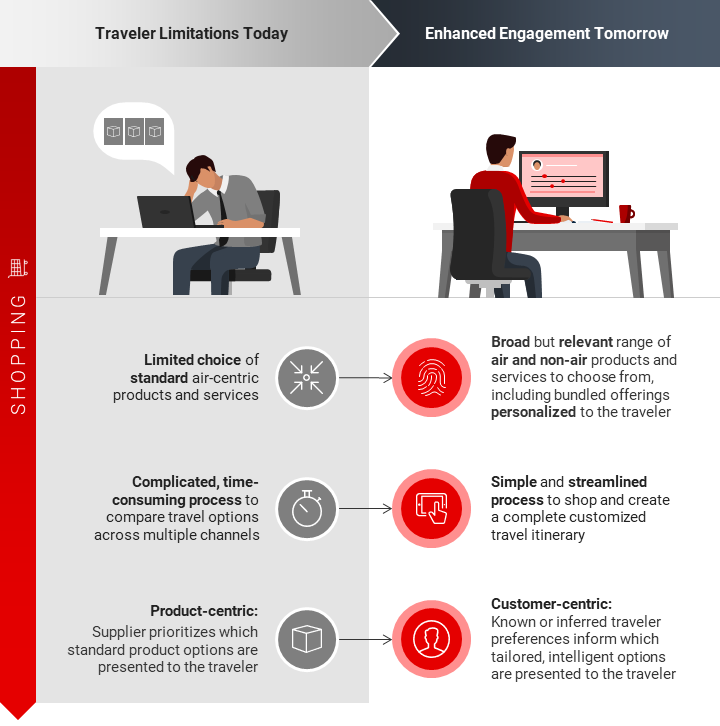
A broader selection of more targeted products and services will enhance the customer experience, improve conversion rates and ultimately drive increased revenue for travel providers.
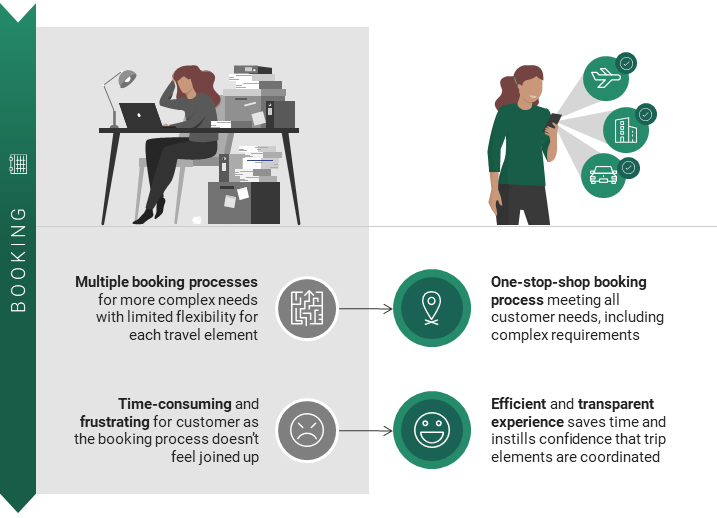
A simple and customer-friendly booking process increases the likelihood of customers booking ancillaries and added value extras .

Consumers want greater choice in how and when they pay for products and services, including travel.
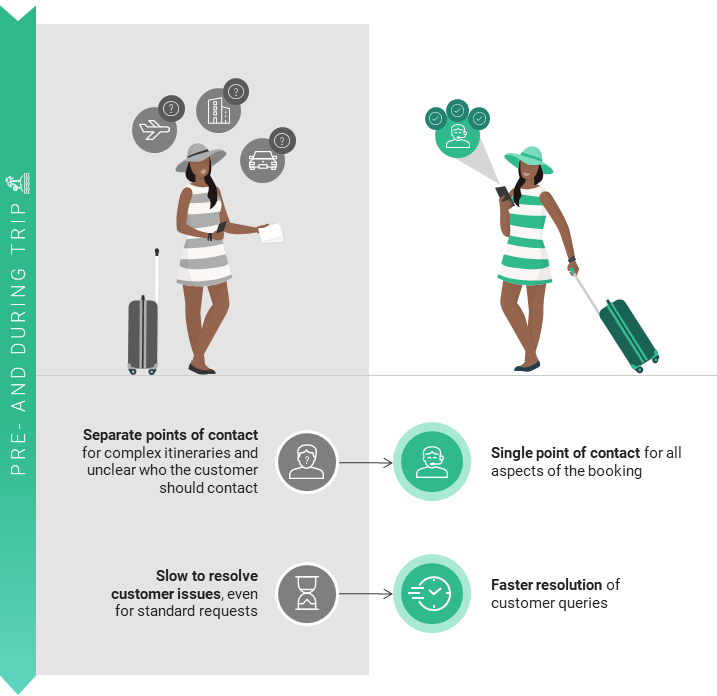
Clear and transparent communication, combined with rapid resolution of issues, increases traveler satisfaction and drives long-term customer value for an airline.
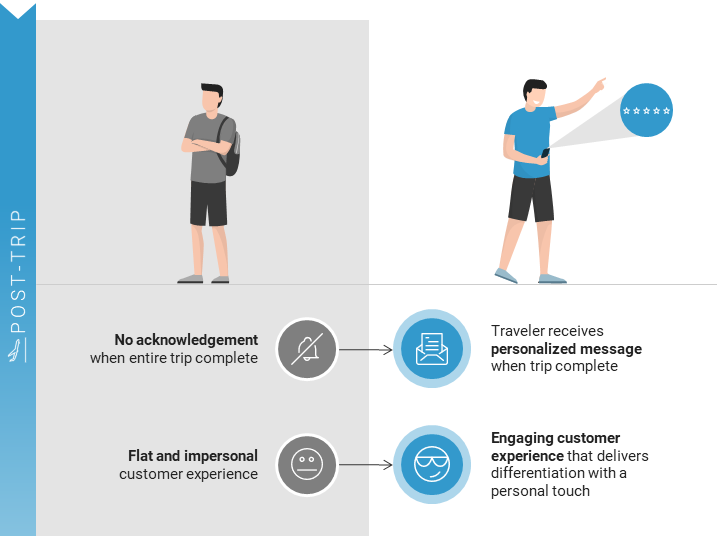
Capitalizing on untapped opportunities to instill consumer loyalty is a proven path to repeat business and enhanced revenue growth .
*Statistics referenced within this article originate from a survey commissioned by Sabre in Q4 2021 comprising over 10,000 global respondents
Responsiveness to change is critical to long-term success.
As we’ve shown in the illustrations above, there are multiple opportunities for the travel industry to progress beyond the principles and processes that brought it to this point in its evolution. The established ways of working may still be fit for purpose, but the travel industry is poised to enter a dynamic new phase in its development – one which offers exciting opportunities for growth and progression beyond those on offer today.
Technological advancements in the last 15 years have catalyzed more innovative and progressive thinking within the travel sector. At the same time, consumer expectations have evolved across all facets of modern life, including travel. People have become accustomed to technology-driven, self-serve, personalized shopping experiences.
To date, in the eyes of consumers, the travel industry – and airlines in particular – have struggled to deliver. The limits of many existing systems and processes have been reached or exceeded, and consumer demands are outpacing the industry’s ability to evolve. Sabre firmly believes that travel providers must pivot towards simplified, scalable, end-to-end solutions that deliver highly personalized travel experiences.
Interested in learning more? From educational resources to industry insights, we’ve got you covered at Sabre.com/open .
Related Post

April 2, 2024
Beyond NDC supports multi-passenger offers
The reason for booking a trip usually informs how many people will be involved. Corporate travel often includes one adult, while leisure trips typically involve multiple adults, or families with young children in tow. Sabre’s NDC...

April 1, 2024
Booking NDC content is easy in the Sabre GDS. Here’s why.
Looking for more detail? Check out our resources for getting started with NDC: Don’t miss out on NDC updates from Sabre! Subscribe to stay up to date on news and fresh resources.

February 26, 2024
Performing while transforming: Three ways to unlock revenue along the path to modern airline retailing
In recent months, there has been a noticeable shift in the industry conversation around airlines’ transition to offer- and order-enabled retailing, with questions like ‘if’, ‘why’ and ‘when’ being replaced by ‘how’. Many have already started...

January 26, 2024
9 questions on modern retailing for travel agencies to ask themselves
Are you discussing modern, offer- and order-based travel retailing with other leaders at your agency? Airlines, tech providers, and many travel retailers are figuring out what the future means for them, and now is a great...

September 25, 2023
Can your agency tech stack meet the demands of modern retailing?
Agency tech stacks will need to be updated to consume new data standards and process more data in new ways. Sabre supports leisure agencies, travel management companies, and online travel agencies to achieve modern retailing success...

August 31, 2023
Rethink your agency operations to achieve modern retailing success
Modern travel retailing, enabled by offers and orders and enhanced with AI/ML solutions, presents new ways for agencies to interact with customers. It also means new processes, increasingly fragmented content, shopping-led instead of schedule-led workflows, and...

July 27, 2023
What Top Gun can teach us about the future of airline retailing
Few movies have stood the test of time as well as Top Gun, and while I’ve let go of my childhood dreams of becoming a fighter pilot, I’m now focused on technological advancements in air travel...

July 25, 2023
Building a strategy for modern agency retailing success
Modern travel retailing, enabled by offers and orders and enhanced with AI/ML solutions, presents new ways for agencies to interact with customers. To capitalize on new opportunities and stay competitive, agency leaders should consider implications to...
Unsupported browser detected, for a better experience please upate to a newer version of Internet Explorer.

4 Key Trends Influencing Travel Retail
As the world begins opening up for travel, the market for travel retail is booming as brands double down their efforts to make up for lost sales during the pandemic.
It is no surprise that the industry expects to grow, and according to business consulting firm Allied Market Research , it will reach $123B by 2023. Travel retail suffered a significant impact due to the COVID-19 pandemic and the ongoing lockdowns in various world regions.
Consumers are undoubtedly anxious to make up for trips lost during the global COVID-19 pandemic, with leisure travel reduced to almost zero and business travel substituted by Zoom meetings. However, the travel retail market is still full of challenges.
Travel retail is a term that commonly refers to sales made in travel requirements. Duty-free and travel retail encompasses the sale of goods to international travelers.
Duty-free shops are exempt from paying certain local or national taxes and duties requiring travelers to take their purchases out of the country. Duty-free sales occur in highly regulated retail environments like airports, ports, ferries, cruise ships, and national customs authorities govern their operations.
Unlike traditional retail environments, airport timetables dictate customers’ shopping habits
Clarity Business Partners reported that in 2013, the average amount of time spent in an airport globally was 150 minutes; this dropped to 133 minutes in 2016 and has continued to decrease in recent years. The average time spent shopping in an airport is 29 minutes–not much time to draw someone in and browse the stores.
In addition to time constraints, there are ongoing issues around baggage allowances and product restrictions.
Often, customers can’t carry everything they might like to buy, forcing them to make difficult choices. These and other external challenges can make it hard to innovate in travel retail. But there are some innovative ways to overcome these travel constraints and present better buying experiences.
Duty-free and travel retail generates vital revenues for national aviation, travel, and tourism industries.
Airports, in particular, incredibly rely on commercial revenues to fund the development of their infrastructure and help them keep fees as low as possible. At airports across the world, retail is now the most significant contributor to non-aeronautical income.
Travel retailers can look forward to growing sales over the next few years
Global duty-free retail will grow 8.5% in 2021, with the number of international passengers increases as the world enters into the “new normal” following the pandemic, according to Technavio , a global market research firm.
However, retailers face challenges getting travels into the stores and enticing them to spend. Only 5-10% of travelers visit duty-free retail stores in the terminal.
Retailers in airports, ferry terminals, and train stations need ways to attract and engage passengers and deliver a unique and convenient shopping experience – no matter what currency their customers use or what language they speak.
Retailers have realized that travel retail provides them with tremendous opportunities to create visibility for their products, increases customer loyalty, and recruit new customers in different countries.
As consumers gear up for long-awaited travel adventures, here are four trends retailers can harness to improve their sales.
Use tech for passenger convenience
Airports, airlines, and ferry terminals are hubs for passenger data because of the multiple digital touchpoints that enable efficient check-in and boarding. Retailers who embrace the desire for digital can provide a seamless shopping experience that entices passengers in the store and engages them before during, and after their trip.
- Partnering with travel operators can unlock access to the travel information needed to create personalized offers and recommendations, starting when a passager books their ticket and checks in for their trip.
- Using data collected from the moment passenger books their ticket to when they check-in for their trip can provide insights into ways to customers with social media. Placing targeted ads and tailored offered is an effective way to create tailored offers that encourage in-store buying.
- Retailers can create loyalty programs with targeted offers that travelers can access easily on mobile devices, encouraging repeat customers and additional in-store buying.
Embrace travelers’ changing shopping habits
Millennials now travel more than any other generation, and it is essential to recognize their different shopping habits.
According to data measurement firm Nielsen , 44 percent of millennials are motivated to buy gifts at the airport, 30 percent shop to treat themselves, and 28 percent make impulse purchases.
The millennial travel shopper is unpredictable, and retailers need to understand their habits to deliver experiences that match their moods, interests, and personalities. Consider these tactics for connecting with the travel generation.
- Connect to travels using their chosen channels, from mobile apps and social media to digitized displays in stores.
- Personalized and location-based deals and recommendations tailed to their interest.
- Use flight info and airport timetables to tailor offers to the travel experience, including passengers’ destination at the time left before they embark.
Checkout should be as fast as check-in
Travelers of all ages value a quick and easy check-in, baggage, and boarding processes, and they will expect the same when paying for their purchases.
There is a need to support different languages and currencies and the regulatory requirements of various destinations, and this can bring complexity and delays to the travel retail checkout.
It is vital that checkout is smooth and efficient, or it could turn customers away. Pay attention to these tactics that can encourage a seamless shopping experience.
- Provide a range of checkout options, including mobile apps, online, self-service kiosks, or mobile POS.
- Travels should be able to check prices in pay in any currency or combination of currencies they choose.
- Use digital tools to support as many languages as possible both throughout the store and at checkout.
Leverage data to optimize inventory
Stocking a retail store with products that match travels tastes is a balancing act. There is limited time to capture customers’ interest, and retailers can’t afford to miss a sale by running out of stock.
The challenge is that there isn’t much room for excessive inventory in a busy terminal or on a ferry. It is for retailers to know what sells well to passengers in various locations to make intelligent decisions on inventory.
- To optimize inventory, use business intelligence tools to see where sales occur and understand shopping patterns. These tools can also provide insight into how passengers in different locations respond to promotions.
- The use of apps and loyalty programs combined with info gathered from customers’ online interactions can provide important insight into travelers’ tastes and interests.
- Integrate retail and supply chain systems for efficient orders and insights into supply and demand.
As travel retail grows, retailers can make their stores part of a seamless travel experience by engaging with passengers with digital and physical channels.
Stay relevant to customers’ needs and interests while providing convenient experiences wherever travelers want to go offers ambitious retailers a profitable opportunity to be a part of customers’ next great adventure.
Recent Articles

Staying Ahead of the Game with Secure Cloud Transitions

Meet The TRE: Timm Henderlight

Accelerate Retail Success in 2024 with These Four Pillars

Future of Shopping: Inside Esselunga’s Innovative AI-Driven Retail Lab
Retailer executives.
" * " indicates required fields
Solution Provider
Solution providers, retail executive.
The Business of Fashion
Agenda-setting intelligence, analysis and advice for the global fashion community.
News & Analysis
- Professional Exclusives
- The News in Brief
- Sustainability
- Direct-to-Consumer
- Global Markets
- Fashion Week
- Workplace & Talent
- Entrepreneurship
- Financial Markets
- Newsletters
- Case Studies
- Masterclasses
- Special Editions
- The State of Fashion
- Read Careers Advice
- BoF Professional
- BoF Careers
- BoF Insights
- Our Journalism
- Work With Us
- Read daily fashion news
- Download special reports
- Sign up for essential email briefings
- Follow topics of interest
- Receive event invitations
- Create job alerts
The Anatomy of Travel Retail
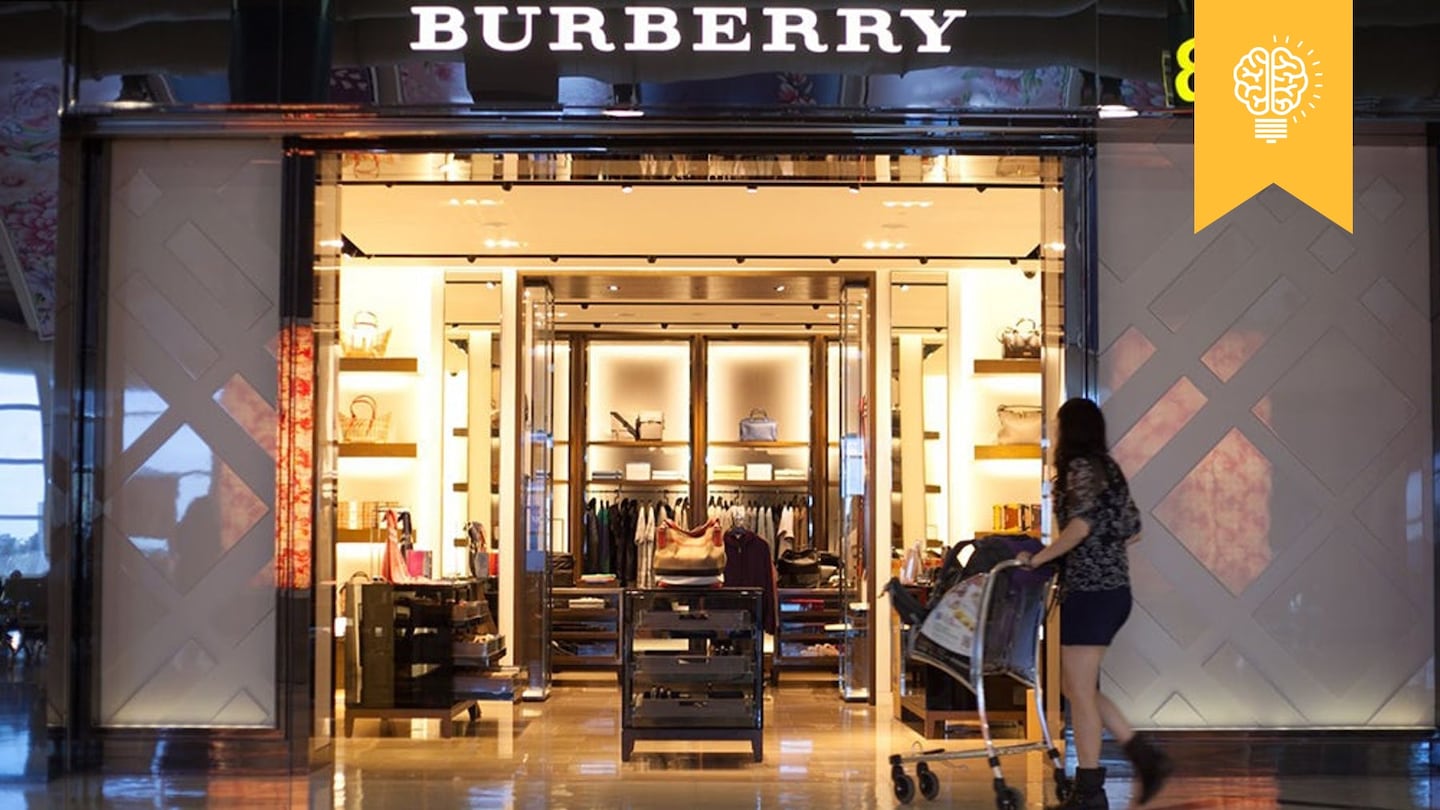
LONDON, United Kingdom — Travel retail typically plays second fiddle in brand communications, which emphasise flagship mono-brand stores. But, people travelling account for 40 percent of global spending on personal luxury goods, with 12 to 13 percent captured by the specialised and globally dispersed travel retail channel.
Airport malls account for almost 60 percent of the travel retail market, but the travel retail channel also includes ferries and cruises, border shops and downtown duty and tax-free shops.
These channels each have their own characteristics. Airport operators typically charge rent as a percentage of sales, which limits the potential upside for retailers as it reduces their operating leverage. Additionally, airport locations normally come with guaranteed minima attached. These can be expressed as absolute dollar amounts, in which case the retailer bears a traffic, consumer mix and execution risk. More frequently however, the dollar amounts are linked to traffic volume, in which case the retailer carries the consumer mix and execution risk only.
By contrast, the economics of downtown travel retail are similar to those of traditional luxury retail operations under fixed rental cost agreements. These stores typically have higher potential for operating leverage. Downtown and border shops compete directly with tax refund and display the same fundamental dynamics; fast growth with the continuing rise in traveller numbers, susceptibility to travel disruption and dependence on key brands. However, downtown tax free stores follow the business logic and constraints of the traditional high street, where tax refunds are available.
ADVERTISEMENT
Tax and duty free stores have a clear price advantage over the domestic market. They also face limited direct competition from other retailers, especially on core categories — airports with two or more operators for a single category are a minority. However, space growth is constrained by the need to win and retain concessions.
Diverse approaches to a complex channel
LVMH is the only luxury goods player with significant direct operations in travel retail, through its selective retail division. The division, comprising of duty free operator DFS and beauty products chain Sephora, booked sales of €9.5 billion (about $10.38 billion) and operating earnings of €882 million (almost $964 million) in 2014. Of this, DFS contributed an estimated 42 percent of sales and 38 percent of profits.
Salvatore Ferragamo is by far the most exposed brand to travel retail, with 138 duty free locations, more than twice as many as the number two, Hermès. It also operates nearly 27 percent of travel retail mono-brand points-of-sale (POS). Hermès and Bulgari follow with 60 and 51 travel retail locations respectively, each with about 19 percent of travel retail mono-brand POS. The list continues with Gucci , Swatch and Cartier.
The brand order is very different in terms of travel retail POS as a percentage of total POS: Shanghai Tang (30 percent), Givenchy (16 percent), Chloé (14 percent), Bottega Veneta (10 percent). But the picture could change as more and more travel retail POS are opened. In the past two years, Swatch has opened 26, Hermès and Givenchy have opened 13, Chloé 11, Bottega Veneta 10, Bulgari 10 and Cartier nine.
Hermès is the most exposed of the high-end brands, by a big margin, with 49 airport locations (Bottega Veneta 19, Chanel seven, Dior three).
Among the mega-brands, Louis Vuitton has the lowest exposure to travel retail, with only two airport locations (Gucci 31, Burberry 22, Prada nine). However, the brand operates 15 downtown locations, piggybacking on DFS Galleria (Gucci 15, Prada 15). This could give Louis Vuitton better marginal headroom for space growth, should it decide to expand more meaningfully into accessible categories — fashion jewellery, eyewear, fragrances and cosmetics, and silk scarves.
Will travel, will spend
The overall market is growing fast, by an aggregate 8.4 percent a year in the past 10 years. This is several percentage points faster than the broader personal luxury goods market and nearly three times as fast as GDP. If we include spirits, cigarettes and electronics, the travel retail market has doubled in value during the period, to about $63 billion.
Asia-Pacific is the largest and fastest growing region for travel retail ($24 billion, 13.8 percent compound growth between 2004 and 2014), with sales largely through airports, and downtown and border shops. Seven of the top eight downtown duty free locations are in Asia. Europe is the second-biggest region ($21 billion), but has the lowest growth (4.4 percent in 2004–14) and is focused on airports ($14.2 billion). The Americas region is worth about $11.5 ($6.3 billion in border shops, $4.6 billion in airports) and is growing by 7.1 percent a year. The Middle Easter and Africa market is about $6.7 billion, focused mainly on airports ($5 billion), with a compound annual growth rate of 12.4 percent for 2004–14.
As may be expected, the biggest country is Greater China (Mainland, Hong Kong, Macau, plus Taiwan), at about $10 billion, followed by South Korea ($8 billion). The third market is USA ($3.8 billion) followed by big western European countries (UK $3.7 billion, Germany $2.9 billion), the UAE ($2.7 billion) and Turkey ($2.2 billion).
However, the travel retail market is by nature sensitive both to foreign exchange rates and to exogenous shocks; terrorism, health scares, financial crises and so on. For example, the weakness of the yen and the euro have encouraged a sharp increase in spend in Japan and the Eurozone, primarily by Chinese consumers — and by Chinese professionals arbitraging price differences by buying in Europe to sell then in China through specialist websites. By the same token, Japanese consumers have withdrawn from international markets. Meanwhile, the stronger United States dollar is feeding hopes of a revival in international American spend worldwide. Currency fluctuations have also been partly responsible for a nominal slowdown in market growth in the last three years.
Conversely, regional diversity helps cushion the impact of external shocks. The buoyancy of Asian and Chinese demand has been further support. By the end of 2010, the travel retail market had fully recovered from the 2009 financial crisis and even exceeded the 2008 level — a strong performance in Asia-Pacific and the Middle East more than offset a slower recovery in Europe and Latin America.
The regional figures also underline the growing importance of emerging-market travellers. They are expected to be one of the main forces behind the forecasted doubling of air traffic in the next 15 years, including sharp increases in domestic air traffic in developing Asia and Latin America. This offers a potentially rich target for travel retail.
The result is a positive double-whammy outlook for travel retail, as emerging market nationalities are also the biggest spenders per passenger. Travel retail should therefore continue to grow faster than the personal luxury goods market.
Luca Solca is the head of luxury goods at BNP Exane Paribas.
- Luca's Letter
- Salvatore Ferragamo
- Bottega Veneta
- London, United Kingdom
- Travel Retail
© 2024 The Business of Fashion. All rights reserved. For more information read our Terms & Conditions

Sneaker Brand On to Launch New Line With FKA Twigs
The British musician will collaborate with the Swiss brand on a collection of training apparel, and will serve as the face of their first collection to be released in August.

Brands Owed Millions After Matchesfashion Collapse
Designer brands including Gucci and Anya Hindmarch have been left millions of pounds out of pocket and some customers will not get refunds after the online fashion site collapsed owing more than £210m last month.
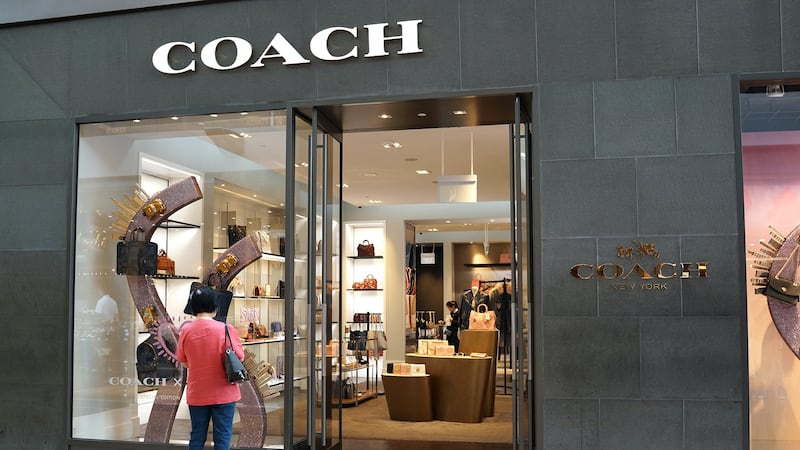
US Sues to Block $8.5 Billion Union of Coach, Michael Kors
Antitrust enforcers said Tapestry’s acquisition of Capri would raise prices on handbags and accessories in the affordable luxury sector, harming consumers.

Op-Ed | How Long Can Adidas Surf the ‘Terrace’ Trend?
As a push to maximise sales of its popular Samba model starts to weigh on its desirability, the German sportswear giant is betting on other retro sneaker styles to tap surging demand for the 1980s ‘Terrace’ look. But fashion cycles come and go, cautions Andrea Felsted.
Subscribe to the BoF Daily Digest
The essential daily round-up of fashion news, analysis, and breaking news alerts.
Our newsletters may include 3rd-party advertising, by subscribing you agree to the Terms and Conditions & Privacy Policy .
Our Products
- BoF Insights Opens in new window


How to Reach us
- Orlando: 407-679-7600
- Tampa Bay: 813-507-3600
- Miami: 954-651-8044
- Boca Raton: 561-289-8719
- Atlanta: 404-689-2118
CFO & Strategic Services
Business resources.

Timely and relevant articles written by Nperspective firm members that provide valuable financial insights.

Access on-demand webinars packed with tips and helpful advice to enhance your business.

From white papers to business templates. Access free financial tools to make life easier.
- Litigation Support
- CFO Insights
The Importance of Travel Retail

After working for a Japanese bank in New York for more than five years, I was sent to Miami to focus on the Travel Retail industry, more commonly known as duty free shops. The Travel Retail or Duty Free Retail industry sells goods to international travelers. Travel retail sales are exempt from taxes when the goods are immediately taken out of the country of purchase.
Vital revenues for the aviation, travel, tourism and maritime industries are generated by travel retail. At airports all over the world, travel retail is the largest contributor to non-aeronautical income. Shopping is a key element of the travel experience for many passengers, and the provision of duty-free retail goods is a service as well as an important revenue generator. More than 1 billion international travelers pass through airports each year, and that number is expected to grow 5% annually, according to industry projections.
Cornerstone of Airport Growth
Travel retail is the cornerstone of airport growth and development with modern airport terminal design recognizing the critical economic role it plays and ensuring new airports come with spacious and vibrant retail spaces.
The top three product categories in global travel retail are fragrances and cosmetics (30%), wines and spirits (17%) and accessories (15%). In 2018, travel retail revenues reached $82.42 billion and are expected to reach $125 billion by 2023.
Travel Retail Keeps Growing
- Increase in travelers – Annually more than 1 billion people travel internationally, approximately 15% of the global population, a figure expected to increase as emerging economies improve.
- The propensity to shop while traveling – travelers have more time to browse in airports designed as inviting shopping spaces.
- Travel retailers use data insights such as advance knowledge of where the customer is coming from and heading, to cater to specific needs. Staff and product displays are organized based on arrival passenger language and cultural sensitivities to ensure that the right products are clearly visible to targeted customers.
- Retailers have a tremendous opportunity to create visibility of their products, increase customer loyalty, recruitment and diversity.
- Aligning luxury with everyday products – travel retail is traditionally a market for luxury and high-end products. So travelers shop for everyday and luxury products in the same location and at significant discounts. High-end luxury product retailers use “minis” and “travel sets” to introduce their products at a discount.
Business Opportunities in Travel Retail
The sector affords SMEs the opportunity to present their products to international travelers at nominal advertising and marketing costs. Large manufacturers see the channel as a cost-effective route to market for new products requiring an international environment.
However, although the channel is lucrative, it is also full of challenges. Air travel requirements – security, passport control, gate closure, etc. – all take time away from browsing and shopping. Another big issue is space. Most travel retail stores, counters and pop-ups operate in a restrictive space, making it difficult to balance merchandizing and positive experience. Baggage allowances and product restrictions also affect the traveler’s propensity to buy.
Taking Advantage of Travel Retail
First is negotiation with airport operators. Travel retail operations are granted via concessions. Concession owners then negotiate with retailers on the appropriate margin based on expected sales volume. Retailers have to negotiate with the operator at each airport if they want to be in that airport and cater to those passengers. Operators look for the retailers that will generate the most sales that translate into more revenue and profit.
According to Moodie Davitt, the largest provider of business intelligence for the travel retail industry, the top five travel retail operators based on sales in 2017 were:
- Dufry – €7.166 billion/USD 8.098 billion (Switzerland)
- Lotte Duty Free – €4.842 billion/USD 5.471 billion (South Korea)
- Lagardere Travel Retail – €3.917 billion/USD 4.426 billion (France)
- DFS Group – €3.670 billion/USD 4.147 billion, Hong Kong based, owned by LVMH (France)
- The Shilla Duty Free – €3.412 billion/3.856 billion (South Korea), owned by Samsung Group
Duty Free Americas, the Miami International Airport concessionaire, ranks #11 with €1.499 billion/USD 1.694 billion in revenue in 2017 and is owned by a Miami-based group.
Additional Insights

EXIT PLANNNING – ARE YOU PREPARED?

Attracting Talent and Retaining Them!

The Current Economic Environment is New Territory for Many CFOs
Valuable business news and insights delivered right to your inbox, follow us on social media, talk to a financial expert.
Do you have a burning business or finance question? Ask one of our top CFOs now!
Orlando | Tampa | Miami | Boca Raton | Atlanta
© 2021, Nperspective CFO & Strategic Services
Privacy Policy | Terms & Conditions
Business Resources
Orlando | tampa | miami | boca raton.
© 2020, Nperspective CFO & Strategic Services

The World’s Top 25 Travel Retailers 2020

The latest rankings have been revealed by The Moodie Davitt Report , through their annual guide measured by 2019 sales prior to the Covid-19 crisis. This is a must read report with plenty of detailed information and insight – the link is provided on this blog post.

The full interactive edition of The Moodie Davitt Report with detailed information behind the rankings and retailers involved can be seen online – click here .

The make up of the Top 25 Travel Retailers has been influenced by organic sales growth and concessions gains and losses but the main story according to The Moodie Davitt Report will be how retailers such as DUFRY Group and China Duty Free Group, come through the current crisis and whether an external player decides to take advantage of the current exposure to come into the channel.

Author Andre de Almeida

Latest M&A in the Drinks Industry – August 2020

Canned Cocktails are Ready To Deliver
Do you find this blog interesting subscribe, leave a reply cancel reply.
Your email address will not be published. Required fields are marked *
Notify me of follow-up comments by email.
Notify me of new posts by email.
This site uses Akismet to reduce spam. Learn how your comment data is processed .
Upcoming Events
Tfwa asia pacific exhibition & conference, annual international beer strategies conference 2024, the campbeltown malts festival 2024, the islay festival fèis ìle, insidethecask.

Email address:
The Spirits Business
Spirits in travel retail: mapping the road to recovery.
Now that passengers are starting to take to the air and the seas, spirits brands in global travel retail are hard at work to make the most of their return.
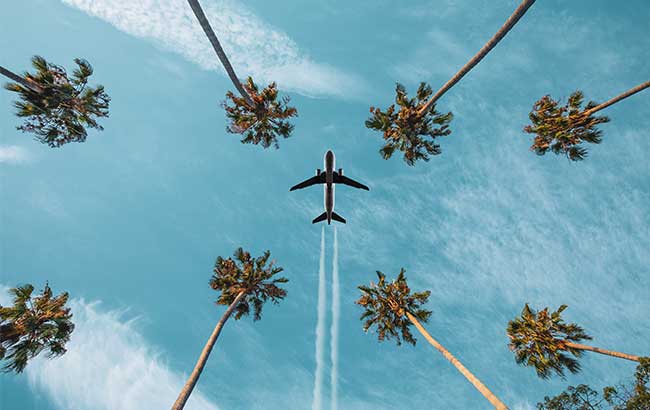
*This feature was originally published in the October 2021 issue of The Spirits Business magazine.
As one of the hardest‐hit sectors, global travel retail (GTR) has had a tumultuous 18 months. As a result of the pandemic, borders were closed, quarantine requirements were introduced, and consumer confidence plunged amid fears of spreading the virus.
However, as vaccination rollouts progress well in countries in Europe, as well as China, India and the US, and border restrictions are lifted, the travel retail sector is poised to recover over the next few years. In the channel, brands and retailers have been forced to adapt to new shopping behaviours.
For spirits producers, GTR remains an increasingly important channel, with brands adopting new and seamless ways to attract time‐strapped consumers who are seeking unique products and experiences.
Challenging times
Jaya Singh, president of the Tax Free World Association (TFWA), says: “The past two years have been some of the most challenging for the duty free and travel retail industry. However, we are starting to see the green shoots of recovery as global vaccination programmes begin to take effect and nations continue to ease border restrictions to allow the free movement of travellers.
“The latest figures from travel research firm Paxsmart forecast that global international departure numbers will return to pre-pandemic levels by 2023, before rising to just under two billion in 2024 – an increase of 9% from 2019.”
According to figures from IWSR Drinks Market Analysis, total spirits volume in the travel retail channel fell by more than 70% in 2020. IWSR expects spirits volume in GTR to grow by an approximate compound annual growth rate (CAGR) of 31% in the five years to 2025, returning to pre‐pandemic volume levels by 2024.
Agave spirits , which reported the biggest drop among spirits in 2020 (down by 79%), will recover fastest, IWSR found. The sector is expected to rise by 39% in volume (CAGR 2020 to 2025), followed by whisky (up by 32% for the same period), vodka (up by 31%) and gin/genever (up by 30%). By market, IWSR analyst Jairo López Suárez says: “2021 is predicted to favour the Americas first, mainly US/Mexico/Caribbean leisure travel, but also functioning land border traffic US/Canada/Mexico and in Southern Brazil.
“Growth in Europe and Asia Pacific will remain somewhat muted until at least early 2022, though Asia is looking more complicated than was originally projected, with some travel forecasts being revised down recently, and vaccination rates in Europe increasing confidence there.”
Travel retail operator Heinemann notes that some spirits categories have been hit harder than others due to the absence of intercontinental shoppers from China, Russia, and the US. “These travellers are traditionally the ones with the largest basket spend – Cognac or baijiu sales, for example, are still lagging behind due to this,” explains Ruediger Stelkens, director of purchasing for liquor, tobacco and confectionary at the firm.
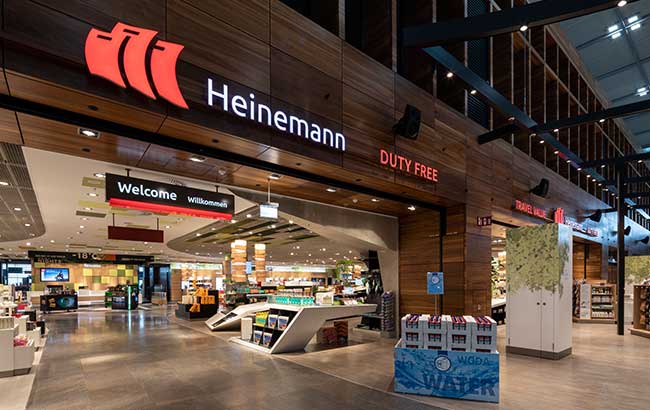
Rare spirits in demand
Stelkens believes that spirits will be among the first product categories to bounce back in travel retail. He also highlights that the demand for rare spirits has been exacerbated by the pandemic. “We’re being offered more and more highly exclusive rare or ultra-premium bottles of aged whiskies and Cognacs,” he notes.
Travel retail operator Lagardère also notes the decline of travellers in Europe, who were “big buyers of ultra‐premium spirits, Cognacs but also Grand Crus wines”, says Victoire Gueugnier, director merchant beverage and tobacco, Lagardère Travel Retail Duty Free Global. Lagardère’s strategy for the channel has been to highlight “best‐sellers at the best price” and give them greater visibility.
“Categories like Champagne and whiskies are really performing better than the rest due to European passengers buying more well-established brands at a good price rather than premium and super‐premium products, which were preferred by the international clientele,” she adds. “Our focus has been to give greater focus to best‐selling references.”
The pandemic caused a revenue decline of 67% for Heinemann in 2020. “We are cautiously optimistic about the year 2021 with a gradual pick‐up in travel, but we are rather expecting a long‐term recovery for our industry that will be clearly felt in 2023 and 2024,” Stelkens adds.
Major spirits players also saw their sales in the channel continue to decline, despite continued investment in GTR. Pernod Ricard’s GTR sales dropped by 40% in its 2021 fiscal year, with the firm expecting a gradual recovery. For the year ending 30 June 2021, Diageo saw GTR sales decline by 62%, with the firm’s Scotch sales plummeting by 60% in travel retail.
Stephen Teeling, sales and marketing director of Dublin‐based Teeling Whiskey Company , notes that the Irish whiskey category remains “very under‐represented” in the channel. But he has noticed that consumers are spending more on spirits, and trading up to more expensive bottlings as they return to travelling.
“While passenger numbers are down, there is a huge increase in spend per customer,” he says. “Dublin Airport said that on its recent short‐haul flights, people are picking up a lot of bottles.” Teeling highlights that the “well-travelled” routes between Ireland and England have also seen consumers spend more in duty free, as well as on Irish ferries.
Ian Macleod Distillers has several “high-profile” activations planned for Glengoyne whisky and Edinburgh Gin in major UK airports in the run‐up to Christmas. There are plans for more activations from its brands in 2022.
“We are launching a completely new, GTR-exclusive aged range from Glengoyne next spring, and have exciting plans for another of our whisky brands, which we will announce later [in 2021],” says William Ovens, business development director.
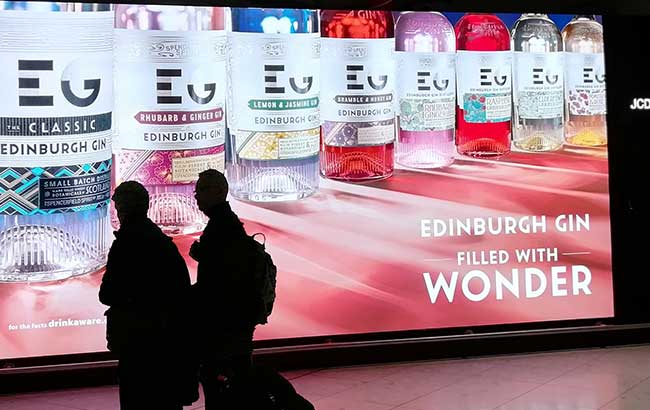
TFWA’s vice‐president, commercial, Donatienne de Fontaines‐Guillaume, highlights the rise of domestic travel in China as a bright spot for retailers and brands. “In particular, Hainan Island has experienced a boom in trade following incentives from the Chinese government to increase citizens’ allowances for off‐shore duty free shopping,” she explains.
“Sales at Hainan’s duty free shops increased by a staggering 127% year on year to just over US$5 billion in 2020, and are continuing to grow. We are seeing a number of spirits brands opening concessions in Hainan to take advantage of this growth.”
In January 2021, Pernod Ricard opened its first boutique for Martell Cognac in China Duty Free Group’s Haitang Bay Duty Free Shopping Centre. It was the first Pernod Ricard‐owned store on the island. This summer also saw Diageo open two permanent shops for Scotch brands Johnnie Walker and The Singleton at the Hainan Tourism Duty Free Shopping Complex in downtown Sanya.
Vinay Golikeri, managing director of Bacardi GTR, called for greater collaboration in the industry: “With online pre‐travel research driving a significant level of decision‐making amongst Chinese spirits shoppers, it is vital that brands and retailers partner in the omnichannel opportunity as Hainan continues to grow – while paving the way for shopper engagement strategies in any future locations that may adopt a similar duty‐free structure to Hainan.”
Teeling is also hoping to collaborate with China Duty Free for Chinese New Year and will work with Dublin Airport on tastings in the fourth quarter.
Digital adoption
Norms around physical distancing and hygiene in travel hubs will ultimately affect how brands and retailers attract customers as they remain cautious about sampling. As such, the implementation of digital solutions has become increasingly important to both protect customers and make the shopping experience simpler.
TFWA’s Fontaines‐Guillaume says: “While we are seeing growing numbers of passengers returning to the skies and seas, their shopping needs will likely have changed dramatically in their time away from travel. Many will now be accustomed to having more control over their purchases through online shopping sites or digital ordering services. At the same time, new concerns over hygiene may dissuade some travellers from tasting and handling products at physical duty free stores, adding a new set of challenges for retailers and brands.”
For Bacardi, the biggest opportunity in the channel is digital adoption, with the company focusing on personalisation and engagement.
“This new behaviour among consumers means there is now an expectation for digital to play an essential role in their retail experience and the evidence proves it is a significant influence on their purchase-decision behaviour,” Golikeri says. “This step-change is fully embedded in the future of shopper behaviour, and we are seeing its positive impact in travel retail.
“We strongly believe this is a truly transformational opportunity for travel retail; to reinvent itself as a unique and exciting omnichannel market.”
Bacardi noted that there is a “great opportunity” to prioritise gifting and GTR exclusives, as well as tap into the trend for at-home cocktail making by providing products, experiences and inspiration for shoppers.
John McDonnell, managing director, international for Tito’s Handmade Vodka, believes the industry would benefit from one app for duty free, similar to Uber, that would enable consumers to get GTR spirits delivered to their homes via contactless payment.
Meanwhile, Heinemann is working on several new projects to diversify its retail and service offering to “meet the ominichannel needs of younger and new target groups”.

One example is new solutions for pre‐order services or digital payment solutions. Teeling also cited Chinese e‐commerce player Alibaba’s purchase of a nearly 10% stake in duty free giant Dufry in 2020. The deal includes a joint venture in China that will combine Alibaba’s digital capabilities and network with Dufry’s travel retail business in the market.
The move could provide the opportunity to have products delivered to your home from the airport, notes Teeling. “People have become used to good service, and will expect things to become a lot easier than they were pre‐pandemic.”
Teeling will focus on collaborative projects in GTR, providing “rich content” such as videos to duty free operators to bring to life the story of the Irish whiskey brand. The company will also roll out its Explorer’s Edition whiskey in Dufry stores in the UK during the fourth quarter of 2021. The producer has planned some special products to celebrate St Patrick’s Day in March 2022.
Cruise industry
IWSR expects the land border, ferry crossing and free zone business to return to strength earlier than the air travel and cruise sectors. The cruise industry has started to reopen, with companies such as Carnival and Royal Caribbean reporting sky‐high demand for forthcoming cruises.
Michael Payne, president of the International Association of Airport and Duty Free Stores (IAADFS) , says cruise ships have been “hurt severely’ by the pandemic.
“Cruise ships in many locations haven’t been able to leave the port for a while,” he adds. “That’s only just starting to open up but they won’t be able to bring as many people on board, which will have an impact on buying.”
Ian Macleod Distillers continues to remain focused on the cruise sector, hosting a stand at the Viking Line’s Cinderella Whisky Fair in September 2021.
“The enthusiasm, knowledge and passion among these consumers was as strong as ever,” says Ovens. “We were showcasing Rosebank, Glengoyne, Smokehead, Shieldaig and the main attraction on the stand, the Viking Line‐exclusive Chieftain’s 24‐year‐old single cask, which all but sold out on the first cruise.”
For Tito’s, cruise ships are a “major focus because we can do activations on ships”, explains McDonnell. Furthermore, the brand is trying to secure more airline listings, having gained some with Aer Lingus and Middle East Airlines before the pandemic. “We’re really pushing the smaller formats of Tito’s in GTR, it’s a good impulse buy,” McDonnell adds.
Broader portfolio
Dutch drinks firm De Kuyper will emphasise its Peachtree liqueur, Cherry Heering Liqueur, and, more locally, Rutte Gin, in airport outlets. “With our broader portfolio we will focus on airport lounges and cruise ships, where we are sure that the global rise of cocktails will give us serious opportunities,” says Mark de Witte, CEO of De Kuyper Royal Distillers.
The move is in line with the company’s strategy to ‘own the cocktail’. “The main challenge is the limited space”, adds de Witte. “Global and local brands are competing for the same shelf space.”
IWSR’s Suárez also highlights that business travel is “increasingly unlikely” to return to its previous extents as consumers adapt to new ways of working.
He adds: “The environment impact of travel is also a pressing concern for many individuals and businesses.”
It looks like you're in Asia, would you like to be redirected to the Drinks Business Asia edition?
Yes, take me to the Asia edition No

- Privacy Overview
- Strictly Necessary Cookies
This website uses cookies so that we can provide you with the best user experience possible. Cookie information is stored in your browser and performs functions such as recognising you when you return to our website and helping our team to understand which sections of the website you find most interesting and useful.
Strictly Necessary Cookie should be enabled at all times so that we can save your preferences for cookie settings.
If you disable this cookie, we will not be able to save your preferences. This means that every time you visit this website you will need to enable or disable cookies again.
Fixing Travel
Travel's back, baby.
Borders are opening. Bags are packed. Planes are full of excited travelers and hotels are bustling. It’s official: travel is recovering.
By the end of 2021, the global travel industry recovered more than 50% of its gross activity compared to pre-pandemic levels. And, if recovery continues along the same trajectory, it could reach 85% by the end of 2022. Compare that to things just two years ago, when travel went from an all-time high to an all-time low of only 5% of expected volumes overnight. Not bad.
But as travel returns, the way it’s sold is also back under the microscope. Because after two years of doing almost everything online, consumers expect better. We asked 2,000 people from around the world how buying travel compares to buying goods, services, and experiences in other industries. This is what they told us.
People want to travel more than anything
Travel is the most eagerly anticipated thing to do in 2022. More than getting fresh kicks. More than going for pizza with friends. More than rocking out at Glastonbury.
People will do almost anything it takes to get away. You’d be surprised at what they’re willing to sacrifice for a holiday.
But buying travel is not so fun
There’s a word for someone who doesn’t like going on vacation. No, not that word (it’s “homebody”). They’re pretty rare though because our research shows that 93% of travelers find traveling either enjoyable or very enjoyable.
Although almost everyone likes being on holiday, the travel shopping experience itself is not sparking joy. And when you hone in on the US — the world’s biggest travel region — the data paints a stark picture. Almost half (43%) of US travelers do not enjoy booking travel. If 43% of the world’s largest travel region are unhappy, the industry has a major problem.
There's a wide experience gap
The experience gap between shopping for travel and actually traveling is noticeably wide. Elsewhere, consumers find the buying experience closer to the joy of what they’re actually getting, like physical goods, electronics, and clothing.
And don't just blame the boomers
It’s easy to assume only tech-wary generations fear booking travel. Unfortunately not. Lots of different age brackets and traveler types aren’t enjoying it. Even digital natives Gen Z, who are the most tech-savvy and comfortable buying everything and anything online.
Shopping should be easier
People aren’t enjoying travel shopping because it’s too complicated. Especially when compared to other items they book or buy every day.
Travel isn’t making it into the top three easiest buying experiences:
- Booking a restaurant online
- Buying clothes online
- Browsing and buying electronic/physical goods online
Can’t build trip
Overcomplicated, too many ads and too much info for each search. Too much hassle to build a trip — instead of asking when you want to go, from where, where you want to stay, for how long, you almost need to book the flights in order to go to the next step.
No combined deals
Why are there no combined (Hotel+flight) deals showing on the new app. I can only click on them separately.
Makes an already stressful operation even more so. The forms do not remember information as you traverse back and forth through the journey. Constantly bombarded about seat selection, along with vague wording on the final screen suggestion you need to select a seat to take a cabin bag. UX is a joke.
Don’t follow their predictions
I was very happy at first and thought this app suggested will save me money! But prices of tickets increased and I lost money!!! Plus. The current prices are always way overpriced compared to other travel apps!
Even travel agencies agree
Our travel agency customers agree that selling travel should be a lot simpler, and that modernizing travel retailing will help them sell more.
Three-quarters (74%) of agents we surveyed agree that buying and selling could be simplified. And 86% of agents agree that modernizing will help them sell more.
It has become so time-consuming that I am having to turn new business away. Right now, I’m their doctor, therapist, attorney and insurance agent along with their travel advisor.

Holly Lombardo, of Holly Lombardo Travel in Atlanta on selling travel in a pandemic
Source: travelweekly.com
Comparison is complex
The lack of transparency when comparing offers is driving complexity in travel. Sure, travel has price comparison sites just like any other industry. But choosing the right deal is about so much more than price, and that’s what makes it harder.
Families (the largest cohort of respondents, at 42%) find comparing offers especially complex. And let’s face it, they have enough on their hands.
One-third of families find it difficult and time-consuming to compare offers when searching and booking flights and hotels. So it’s no wonder that a quarter (23%) of families don’t enjoy looking for and booking trips.
Of families find comparing offers difficult and time consuming
Other industries make it easier.
Retailing greats like Amazon help customers make decisions by showing products in a like-for-like way. They aren’t afraid to give them all the information, and let them choose.
Comparing travel products is unfortunately seen more akin to evaluating mortgage or car insurance options. And who wants to be known for being time-consuming, stressful, and bamboozling consumers? That’s why, on average, travelers visit a whopping 38 sites before booking a trip.
The verdict is: nontransparent = more complicated = less fun. Poor comparison options also add to the feeling of ‘hidden costs’, which erodes trust — and 60% of customers think travel isn’t up front enough.
Fashion proves one size doesn't fit all
People think the travel industry is poor at remembering their preferences and sending personalized offers based on their booking history.
Some retailers know their customers inside out. And they know how to target them too. Major fashion retailers like Shein, Zara, or ASOS reject the one-size-fits-all approach, and instead tailor ads and use hyper-personalization to capture customers by preferences, buying history, and individual style. But travel isn’t measuring up to that standard.
The digital experience needs an update
Other industries have steamed ahead of travel in terms of simplicity and innovation. Customer expectations have changed, and they’re getting more sophisticated every day. The travel industry, on the other hand, has even slipped behind banking in how people perceive its innovation. Yep, even less innovative than banking.
Customers are putting up with bad retailing experiences, because they love being on vacation. That’s a risky situation. All it takes is one disruptor to move in on travel’s blind spot to pose a real threat to the industry. Just look at how banking and finance have had to scramble to react to new competitors like Revolut and Venmo.
Booking business travel is behind leisure
Business travelers are still travelers. They expect the same experience when booking corporate travel as booking a vacation. But they aren’t getting it. 87% say booking business travel should be as easy as booking a holiday. But 42% say it’s actually more difficult.
Our travel agency customers recognize that change is needed, and agree that retailing standards should be similar across both leisure and corporate travel. 82% of corporate travel agents say modern digital retailing and customer experience applies to business travel as well as leisure travel.
(*Emphasis on the ‘should be’. 42% say it’s actually more difficult)
Only Agencies Can Fix Retailing
Travel retailing needs an upgrade, but who’s going to do it? Our view is: travel agencies are the only players in the market that are truly capable of delivering the modern retailing standards that other industries thrive on. And here’s why.
Convenience is crucial
People want a travel shopping experience where they can search and book everything in one place. That’s why agencies are best placed to be the drivers of innovation in our industry, and become truly modern travel retailers.
45% of respondents would prefer to book an entire trip through one website, one that offers choice of airlines, hotels, car hire companies, and extras. In particular, the youngest generation of travelers want agencies to step up their retailing game. 50% of Gen Z would prefer to book an entire trip through one website.
Choice beats price
Customers don’t want the cheapest option. Their main concern is seeing everything on offer. And the truth is, only travel agencies have the breadth of choice to deliver real retailing. They can offer more than any one airline or hotel website can.
Ready to retail
Travel agencies know their unique value in the retailing challenge. And they’re ready to build on that value by modernizing the way they sell.
Three building blocks for modern retailing
Wider breadth of choice.
Travelers fear not seeing everything on offer. They want options, lots of options. The way to reassure them they’re not being duped is to have the breadth of content needed to build trust.
That’s not just the cheapest fares, it’s the best fares, the most suitable fares, the most convenient fares, and the ones people will actually buy, all in one place. In travel retailing, choice is everything.
Modernized merchandising
Matching the right product to the right consumer quickly, easily, and transparently means redesigning merchandising. Travel must move beyond tweaking every screen to earn an extra cent, and sell at the right time with booking tools that are simpler than the standard, confusing series of forms and tables.
The most successful retailers sell the sizzle, not the steak. Travel can drive an emotional lift with visuals like reuniting with family, meeting colleagues face-to-face, or sipping a piña colada by the pool.
Customer centricity
Repeat business depends on making customers happy. But travel brands tend to specialize in one step of the journey, rather than delivering across the full trip. That means missed opportunities to improve the experience pre-trip, in-trip, and post-trip.
You don’t need a points-based loyalty program — it’s about finding ways to connect, inspire, and impress. Optimizing and automating with self-service, data, and insights can both reduce costs and improve customer experience — but avoid trade-offs between those goals.
The reward for retailing
The benchmark of successful modern retailing is true loyalty and repeat business. By restoring clarity, confidence, and fun to travel shopping, we can grow trust and improve the way travel is perceived compared to other industries.
Whether looking at better content, modern merchandising, or more customer centricity, the focus must be on delivering lifetime value. This is the path to better, longer-term relationships with customers and breaking the cycle of re-acquisition which plagues the entire travel industry.
The industry was once seen as a retailing pioneer — in fact, flight tickets were the first items to be sold online. And travel can be a leader once again. But we need to learn from outside our comfort zone and take lessons from retailing greats in other industries. And we need to sell to customers in the way they want and expect.
Retailing elsewhere is constantly advancing. If travel businesses that don’t follow suit, we’ll be left behind for good. We’ve got a unique opportunity in having the dream product to sell, and people who are desperate to buy it. So, let’s get out of our own way, and sell it right.

Methodology
This research was undertaken in conjunction with Toluna Corporate Insights, to investigate traveler sentiment around the ease of travel shopping compared to other industries. We surveyed over 2000 people from different demographics across seven different countries including the US, UK, Australia, Hong Kong, India, Singapore, and the United Arab Emirates.
Travel agency sentiment was also measured through Travelport’s Customer Voice portal. Travel recovery data and predictions are based on MIDT data.
App store reviews are taken from various travel brands’ apps on the iOS App Store and anonymized for this report.
WH Smith shares fall on lower growth after travel boom
- Medium Text

Sign up here.
Reporting by Prerna Bedi in Bengaluru; Editing by Varun H K
Our Standards: The Thomson Reuters Trust Principles. New Tab , opens new tab

Business Chevron
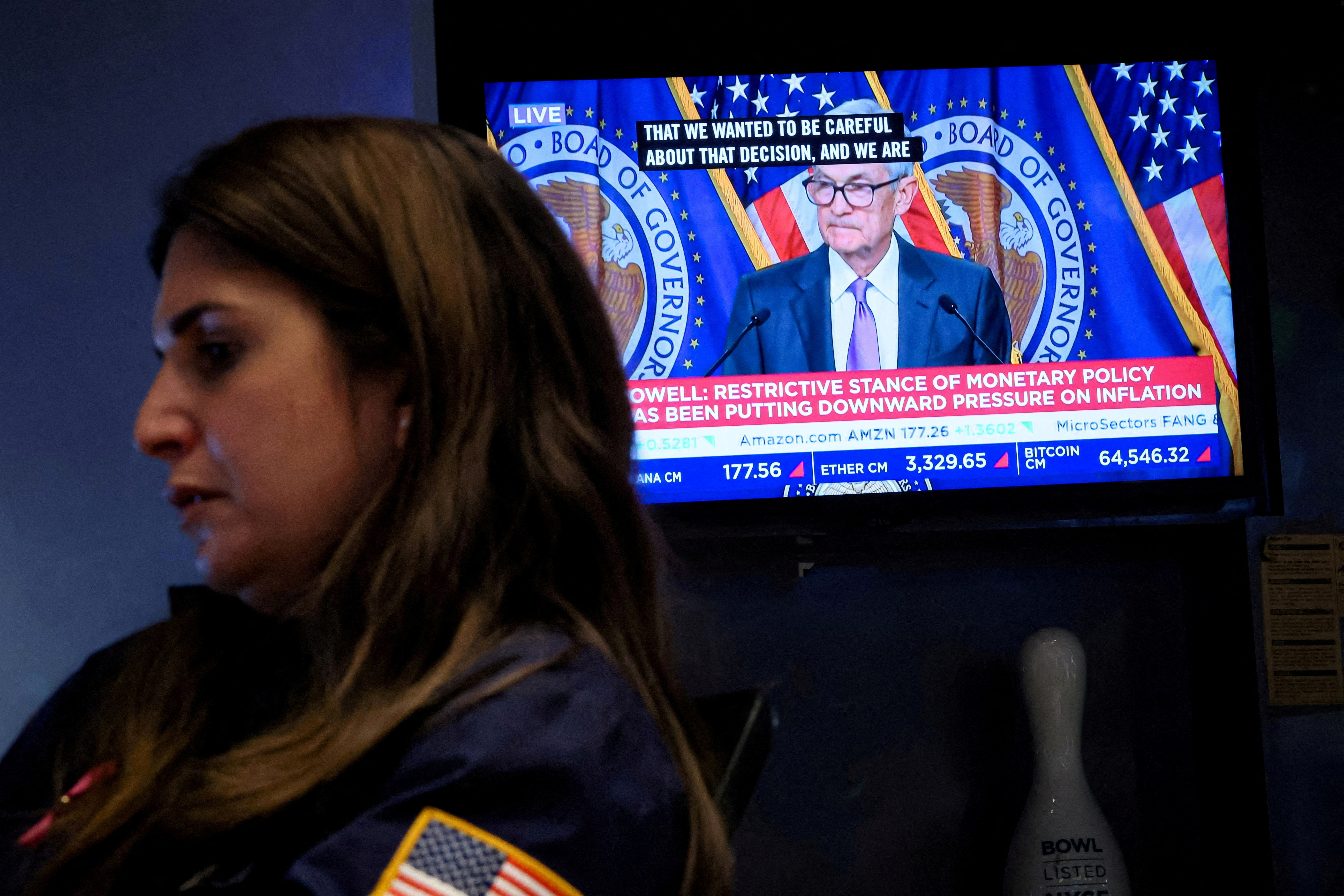
Wall St falls in lead up to Fed verdict after hot labor costs data
Wall Street's main indexes fell on Tuesday with caution prevailing ahead of the Federal Reserve's interest-rate decision and as stronger-than-expected labor costs hinted at persistent inflation.


site categories
Ruben östlund, chie hayakawa & lorcan finnegan projects selected for 2nd cannes investors circle, breaking news.
- Arnaud Lagardère Forced To Resign As CEO Of Vivendi-Owned Publisher & Travel Retail Giant Due To Indictment
By Melanie Goodfellow
Melanie Goodfellow
Senior International Film Correspondent
More Stories By Melanie
- Gérard Depardieu To Stand Trial In October For Alleged Sexual Assault Following Police Questioning
- Luxbox Seals French Distribution Deal For Cannes Critics’ Week Title ‘Simon of the Mountain’ & Unveils Trailer

Arnaud Lagardère , head of Vivendi -owned French publishing and travel retail giant Lagardère Group , has been forced to resign as CEO of the company following his indictment related to accusations of embezzlement.
“This indictment essentially concerns facts relating to personal companies wholly owned by Arnaud Lagardère and not involving any Lagardère group companies,” the company said in a statement on Tuesday.
Related Stories

Studiocanal Launches Literary Adaptations Label & Promotes SVP Sarah Reese Geffroy To Run It - Updated

Canal+ Owner Vivendi Posts $4.6B Revenues, Updates On Company Split Study
News of the forced resignation followed reports on Monday that Lagardère had been questioned by a Paris judge in relation to accusations of embezzlement.
The Lagardère Group, which was founded by Lagardère’s father Jean-Luc Lagardère in 1992, is home to publishing giant Lagardère Publishing and Lagardère Travel Retail. Its assets also include Paris Match and Le Journal du Dimanche and top radio stations Europe 1.
Vivendi took full control of the Lagardère Group in November 2023 following approval from European Commission, under its EU merger legislation,in return for selling publishing assets Editis and Gala magazine, which was part of its Prisma Media subsidiary.
Lagardère was retained as CEO of the group.
Must Read Stories
A24 re-teams with ‘talk to me’ directors on sally hawkins horror.

Disney+ Gives ‘Let It Be’ Movie A Release Date & Trailer After Half-Century
Q1 earnings; par+ subs update; bakish exit official; skydance’s final offer, no. 7 ‘taylor swift: the eras tour’ put swifties in the seats en masse.
Subscribe to Deadline Breaking News Alerts and keep your inbox happy.
Read More About:
No comments.
Deadline is a part of Penske Media Corporation. © 2024 Deadline Hollywood, LLC. All Rights Reserved.
Eat, sleep, live luxury: LVMH is building whole cityscapes centered on their designer stores
- Luxury powerhouse LVMH is investing billions in real estate, The Wall Street Journal reported.
- The company's strategy involves purchasing older properties and creating new city centers.
- The company spent $2.1 billion last year acquiring properties in Paris ahead of the Olympic games.

Louis Vuitton Moët Hennessy , the brand behind some of the most well-known names in fashion, wines, and spirits, is reshaping older neighborhoods across the globe into luxury plazas and shopping centers.
According to The Wall Street Journal , the parent company of brands like Louis Vuitton, Dior, and Fendi, as well as private equity firm L Catterton, is betting billions on in-person shopping by buying old shopping centers, hotels, and warehouses and turning them into mixed-use centers focused on their brands.
According to the report, much of the strategy involves buying property in sometimes historic neighborhoods — like the Pont Neuf neighborhood in Paris, which sent lawsuits LVMH's way from historians concerned about the integrity of the 150-year-old La Samaritaine department store — and transforming them into affluent neighborhoods by working with world-class architects like Frank Gehry to construct shopping centers.
Michael Burke, head of LVMH Fashion Group , told the Journal, "We're creating a city."
"We take something that does not exist and when we're done a city center has been created with the residential, retail, and cultural aspects to it," Burke told the outlet. "Most of our brands were brands that had fallen on hard times. Just like this real estate, we bought it because it was derelict. In ruins." The "derelict" real estate includes areas like Miami's Design District, where the company turned 30 acres of warehouses and abandoned office buildings into a luxury space with museums, offices, and — of course — a retail center. Over 14 years, LVMH and a local developer took over blocks of the warehouse district. Now, asking rents for retail space in the area have increased by 200% since 2019, the Miami Design District said in a blog post, citing investment management firm JLL.
Burke told The Journal that the company's introduction to the world of real estate was in 2010 when he convinced CEO Bernard Arnault to revitalize the warehouse district in Miami. The company now has multiple sites in other cities internationally, including Paris and Montreal. According to the Journal, the company spent $2.1 billion last year acquiring properties in Paris ahead of the Olympic games.
Related stories
The luxury brand is among several spending billions on luxury stores and experiences. Kering, the company behind Gucci and Saint Laurent, spent $1.4 billion on a building in Milan's Via Montenapoleone.
Chanel and LVMH are also interested in purchasing properties on New York's Fifth Avenue and the Champs-Élysées in Paris, the Journal reported.
The large-scale purchases are not without their controversies, however.
In Paris, The New York Times previously reported, luxury giants buying up property in the Marais district of Paris are contributing to the displacement of low-income immigrant businesses.
"This used to be a real neighborhood, with families and kids," Amar Sitayeb, a mini-mart owner, told the Times of the Marais district. "Now, all that's disappeared."
The Journal also reported that residents in Montreal, where the company has poured $1.5 billion into a mixed-use luxury shopping center called Royalmount , are apprehensive about the development's effect on the city's already established downtown. The Royalmount replaces a historical industrial site .
Global News Canada reported in 2019 that the project is estimated to increase car traffic by between 20,000 and 70,000 cars daily. The company responded by building a footbridge that connects the shopping center to Montreal's public transit network. "Without proper planning and without transportation alternatives integrated and implemented, is almost like a recipe for chaos," Saint-Laurent Borough Mayor Alan DeSousa told Global News at the time.
LVMH did not immediately respond to a request for comment from Business Insider.
Watch: Marriott International's Tina Edmundson tells Insider that the travel mindset has changed since the pandemic
- Main content
Moodie Davitt Report
Connect with us
Spirits and Wines
William Grant & Sons names Rufus Parkinson as Managing Director – Global Travel Retail

Rufus Parkinson has been named Managing Director – Global Travel Retail at family-held drinks company William Grant & Sons.
Parkinson joined the group in June 2023 as Regional Director Global Travel Retail for Europe, the Americas, India and the Middle East.
Fluent in Mandarin, Parkinson has an extensive background in luxury consumer brands, FMCG and retail, and has previously held senior leadership roles at Moët Hennessy and Mars. He is charged with steering the group’s GTR team as it continues to build on established leadership positions within the premium spirits sector, and brings “a depth of brand building and global commercial expertise” to his new role, said the company.

Commenting on Parkinson’s appointment, William Grant & Sons Chief Commercial Officer Doug Bagley said: “I am confident that Rufus’s experience will allow him to drive our GTR channel to ensure long-term sustainable value growth.”
Parkinson noted: “I am delighted to take on this key role and explore new ways in which to meet the evolving demands of travelling consumers – and our retail partners. The resurgence of the luxury spirits segment within global travel retail offers so many exciting opportunities, and we will continue to push the boundaries of innovation in order to deliver memorable brand experiences, drive footfall and uplift sales.” ✈

Follow us :
The Moodie Davitt Report Newsletter
Subscribe to our newsletter for critical marketing information delivered to your inbox
Related Articles

The award by Influential Brands is based on a survey of 500 tourists’ preferred destinations within Singapore.

The wine group says: “This collection shows the evolutionary journey of Chilean vines as they develop over 20, 40 and 70 years.”

The Moodie Davitt Report was on location for the tasting event which highlighted the travel retail-exclusive 23 year old and 30 year old Wildmoor expressions.


IMAGES
COMMENTS
Travel retail pertains to creating, planning, and providing travel services, while at the same time, engaging in sales activities to cater to the shoppers' demands while they are in transit. The growth in the travel retail market is mainly attributed to four main factors which are discussed below: Except the aberration witnessed in the last ...
Travel retail is the sale of goods to travelers outside their normal duty-free or domestic-sales environment. Travel retail is a global industry that generates over \$50 billion in annual sales. History of Travel Retail. The first duty-free shops were established in the early 1900s in Europe.
Duty free and travel retail is a global industry which specializes in selling products to international travelers. Duty free store sales are tax-free and exempt from excise duties, on the ...
Then, when physical stores shut down in 2020, retail sales fell 20% from February to April. As aircraft were grounded, the travel retail industry weathered severe losses. Although we're now in the ...
Travel retail is a term that describes retail outlets that sell products to end consumers in a travel environment. Some of these shops are duty free, where customers are exempted from certain local taxes and duties, and in this case shops usually require proof of travel, such as a boarding pass, to complete the transaction. ...
With the post-pandemic travel boom ongoing, travel retail is set to surpass $117 billion in global sales by 2030, growing at nearly +10% annually from 2022. To meet rising traffic and enhance ...
Travel retail, and airport retail in particular, has been experiencing tremendous growth in the past few years. Industry experts expect airport sales to maintain the positive trend, improving every year to reach $100 billion in ten years, which means maintaining an annual growth rate of around 12%. The figure is impressive - the luxury good market is expected to grow at half the speed.
The travel retail market size was valued at USD 60.72 billion in 2023 and is projected to grow from USD 66.30 billion in 2024 to USD 145.46 billion by 2032, exhibiting a CAGR of 10.32% during the forecast period. Travel retail businesses offer products in travel environments, such as cruises, airports, and airlines.
Modernize concepts: A purely transactional approach to travel retail is no longer enough. Players must develop concepts such as retail-as-a-media, where capturing data points on passengers is more valuable than making a sale. This involves showcasing, for example, electronics, with customers able to try out new products provided they register ...
Travel retail should enable purchasing at every stage of the customer journey, from booking and other pretravel activities, to time spent in the airport, to in-air travel—all the way through to after deplaning. A strong partnership among industry players, which a third-party technology provider could help to anchor, is critical. ...
A McKinsey survey reveals traveling to be the second-most-desired activity among respondents (in first place: dining out). In the United States, air travel has hit two million daily passengers, closer to the prepandemic level of around 2.5 million than to the low of around 90,000, in April 2020. Hotel reservations and rental-car bookings are ...
Dufry is a Swiss-based travel retail company established in 1865. It operates more than 2,300 duty-paid, duty-free shops and convenience stores in cruise lines, seaports, railway stations, airports, and central tourist areas worldwide. The company is headquartered in Basel, Switzerland and employs approximately 36,000 individuals worldwide. ...
Regional News. Channel News. Product News. Data & Analysis. Video Channel. Sustainability. TRBusiness is a world leading B2B media and event company, it provides news reporting and unrivalled analytical commentary to the global travel retail industry.
The Future of Travel Retailing: Elevating the Passenger Experience. Sabre is forging ahead in its ambition to modernize travel industry standards and accelerate retailing transformation, standing shoulder-to-shoulder with IATA in a shared vision for the future. Over the coming weeks, we will lead you step-by-step on that journey towards change.
Travel retailers can look forward to growing sales over the next few years. Global duty-free retail will grow 8.5% in 2021, with the number of international passengers increases as the world enters into the "new normal" following the pandemic, according to Technavio, a global market research firm. However, retailers face challenges getting ...
If we include spirits, cigarettes and electronics, the travel retail market has doubled in value during the period, to about $63 billion. Asia-Pacific is the largest and fastest growing region for travel retail ($24 billion, 13.8 percent compound growth between 2004 and 2014), with sales largely through airports, and downtown and border shops.
Product, Design, and Data Platforms. Sustainability. Transactions and Transformations
Travel retail sales are exempt from taxes when the goods are immediately taken out of the country of purchase. Vital revenues for the aviation, travel, tourism and maritime industries are generated by travel retail. At airports all over the world, travel retail is the largest contributor to non-aeronautical income.
Travel Retail: beauty for all travellers. Although the pandemic significantly impacted air traffic worldwide, Travel Retail successfully reinvented itself in 2021. L'Oréal relied on its brand portfolio, its keen consumer insight and its technological expertise to meet the aspirations of travellers around the globe.
Travel retail needs to embrace omnichannel after Covid-19. The global duty-free and travel retail market was valued at $74.9 billion in 2017, and projected to reach $153.7 billion by 2025, fuelled by the wider growth of the travel and tourism industry. Covid-19 has hugely hampered the growth of the travel retail sector, however, with the ...
The World's Top 25 Travel Retailers 2020. The latest rankings have been revealed by The Moodie Davitt Report, through their annual guide measured by 2019 sales prior to the Covid-19 crisis. This is a must read report with plenty of detailed information and insight - the link is provided on this blog post. The full interactive edition of The ...
Travel retail is poised for recovery in 2022 *This feature was originally published in the October 2021 issue of The Spirits Business magazine.. As one of the hardest‐hit sectors, global travel ...
The reward for retailing. The benchmark of successful modern retailing is true loyalty and repeat business. By restoring clarity, confidence, and fun to travel shopping, we can grow trust and improve the way travel is perceived compared to other industries. Whether looking at better content, modern merchandising, or more customer centricity ...
Last month's retail sales, released April 15 by the U.S. Commerce Department's Census Bureau, closed out a first quarter that has been much more of a boon for retailers than many observers ...
, opens new tab shares fell 9% on Thursday, after the British airport retailer flagged lower growth at start of the second-half after a strong travel boom last year. The group, which runs stores ...
AI is everywhere and while many people and industries are worried about their future because of artificial intelligence, some sects of the global workforce are looking forward to integrating with ...
Arnaud Lagardère, head of Vivendi-owned French publishing and travel retail giant Lagardère Group, has been forced to resign as CEO of the company following his indictment related to accusations ...
Arena Group Editor at Large Daniel Kline focuses on the travel industry while also writing about retail, pop culture, and technology. Follow worstideasTST.
Now, asking rents for retail space in the area have increased by 200% since 2019, the Miami Design District said in a blog post, citing investment management firm JLL.
Parkinson joined the group in June 2023 as Regional Director Global Travel Retail for Europe, the Americas, India and the Middle East. Fluent in Mandarin, Parkinson has an extensive background in luxury consumer brands, FMCG and retail, and has previously held senior leadership roles at Moët Hennessy and Mars. He is charged with steering the ...